I am very thrilled to have the honor of interviewing the cinematographer Roberto Schaefer ASC. Over the last decade he has been the director of photography on “Monster Ball”, “Stay”, “Stranger Than Fiction”, “The Kite Runner”, “Finding Neverland” and, most recently, the latest installment in the Bond series, “Quantum of Solace” featuring Daniel Craig, Olga Kurylenko, Judy Dench and Gemma Arterton. Roberto has been gracious to find time in his busy schedule to talk about his work on “Quantum of Solace” and the visual turn that the iconic series has taken since Daniel Craig has joined it.
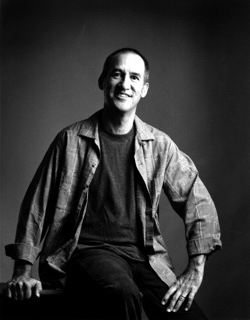 Roberto’s picture courtesy
Roberto’s picture courtesy
of Douglas KirklandKirill: Tell us a little bit about yourself and your path to become a cinematographer
Roberto: I am a graduate of a fine arts college where I majored in Multi-Media which at the time was mostly conceptual, installation and every other art that didn’t fit into the classic categories. I minored in still photography. When I was growing up I, as so many others did, made films with my father’s 8mm camera and later on super 8mm, usually inspired by songs or sounds. I endeavored to become a fine artist but was somehow swayed into the path of commercial motion pictures by way of feature news, documentaries, music videos, and TV commercials.
Kirill: What is the essence of what you do, and what advice would you give to aspiring cinematographers?
Roberto: I attempt to find images in the words that I read on the page, and what is in between the lines. Look within yourself for inspiration and believe in your gut instincts.
Kirill: “Quantum of Solace” is 22nd movie in the Bond franchise. Did you spend time researching the previous installments to keep some of the visual elements?
Roberto: Along with the director and the production designer we watched most of the earlier films to look for the keys to the kingdom. In the end I think that we were most taken with the “Goldfinger” period and the 1960’s design aesthetic. I paid homage to that film in one of our iconic setups where the girl was covered in oil instead of gold. I did a match frame to the original shot but with out the cheeky chair.
Kirill: With Daniel Craig playing Bond in “Casino Royale”, the movies have transitioned to a more gritty, dusty, cutaway type of action. How does this affect your planning and execution?
Roberto: Following the lead set in Daniel’s first outing, “Casino Royale”, we needed to keep him more real, less enigmatic. We tried to allow his persona to show through his emotions and personal attachments while allowing him to be brutal and ruthless in his quest. In doing so we allowed him to guide us on his journey and kept it real. Action sequences and the like were kept more realistic than earlier Bond adventures. There was an attempt to achieve a more tactile, more visceral effect to the fights and chases. Marc Forster [director] and I worked very closely with 2nd unit to plot out the frames and action that they would shoot and we joined with them on several occasions to overlap 1st and 2nd units in order to try and keep a uniformity to the film.

Kirill: What happens in the weeks before the shooting begins? Do you scout locations, discuss storyboards, try preliminary shoots?
Roberto: We were very fortunate on “Quantum” with the extreme support of the producers to have ample prep time to scout possible locations very early on. Then when the choices were made we went back to plot our scenes and later again for the tech scout. In the meantime Marc and I sat for weeks going through the entire script from cover to cover and back again to make shooting plots and lists for the entire film. That was to work off of like a blueprint for all departments to understand our vision. We didn’t do any storyboards but we did do the aerial diagrams that we’ve done for most of work together. I did some early testing on film and cards to find the look that I was hoping for. The only thing we couldn’t do was shoot anamorphic due to a very constrained post schedule with a release date already in place 4 1/2 months from picture wrap!
Kirill: Most of the scenes in “Quantum of Solace” were filmed in outside daylight. What difference does this have over your control of lighting?
Roberto: I don’t really think of it as mostly in outside daylight. If you consider 55 vs. 45% it may be possible but I’m not convinced. In any case as in any scenes shot day exterior you need to try and control scheduling so the relation of the sun to your location works at the various times of day. And there is often need for more large diffusion or negatives control as well as bigger lights to keep the light consistent throughout a scene which might take several days to shoot.
Kirill: The high-tech setting of MI6 office is washed in wide swaths of white light. What is the message and how do you convey it?
Roberto: I guess that I need to rewatch the film because I don’t recall that much wide bathing of white light. For sure in M’s office there is a large frosted window to give an opportunity to make a severe lighting change when the walls in her office shift to viewing screens. This was an effect we shot with motion control as the aide goes into her office but it was eventually cut from the film due to the length of the scene.
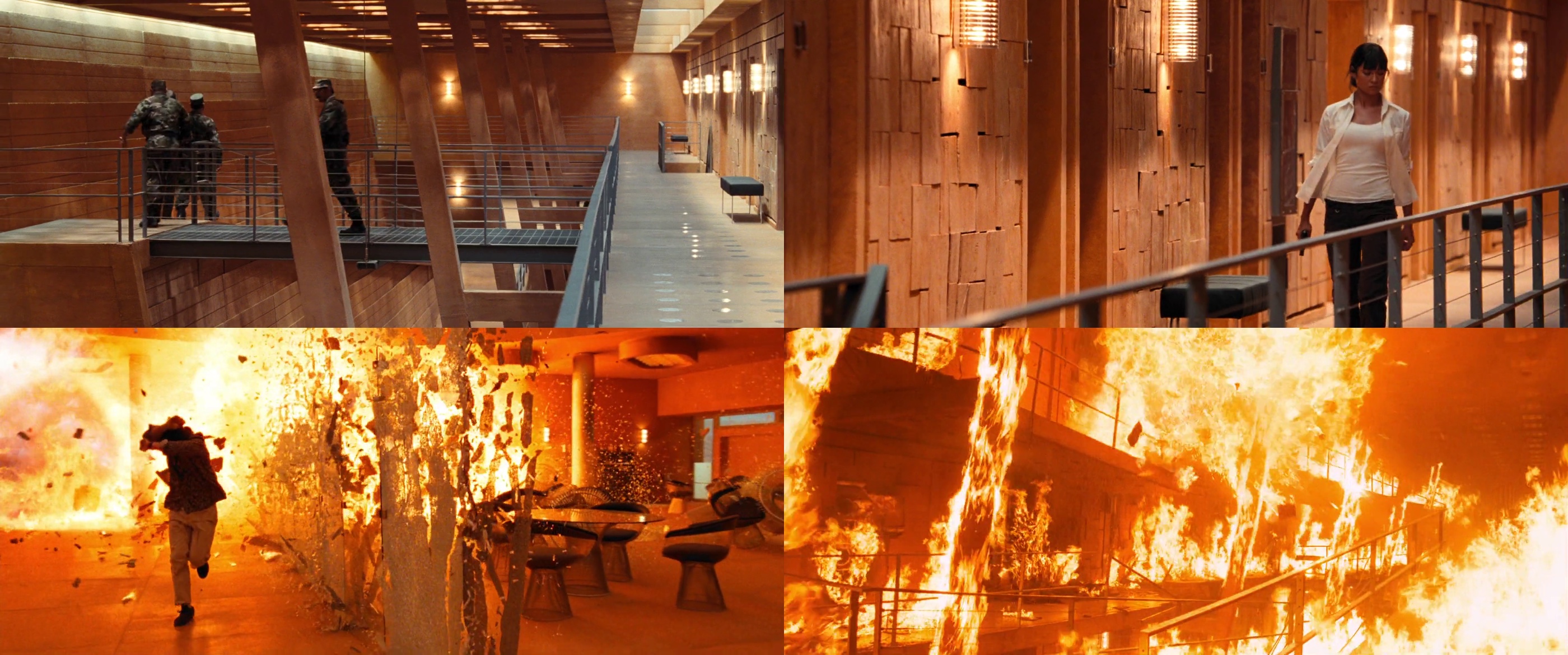
Kirill: The last scene in a secluded Bolivian facility is full of explosions and fire. How does this affect or limit your equipment and shot setup?
Roberto: That entire scene of the interiors was shot on the big 007 stage at Pinewood. The set was built full length which was about 2/3 the size of the real hotel in Chile where we shot the exteriors. The SFX team did real explosions, air canons, and fire on stage, most repeatable. It is always tricky working around real flames and burning set pieces but we took all safety precautions and put the cameras as close to the positions that I wanted as possible. We used a telescopic crane as well as dollys, tripods and hand held to get what we needed. The flames were mostly controllable so we never felt too at risk. The stuntmen and Daniel did have to be covered in fire retardant gel for some of the shots, especially those running through the burning hallway and into the final room. I worked very closely through months of prep with the SFX co-ordinator to ensure that we could get the best shots to tell the story. I showed him my ideas of coverage and he did his best to make it work as well as some great suggestions for the sequences.
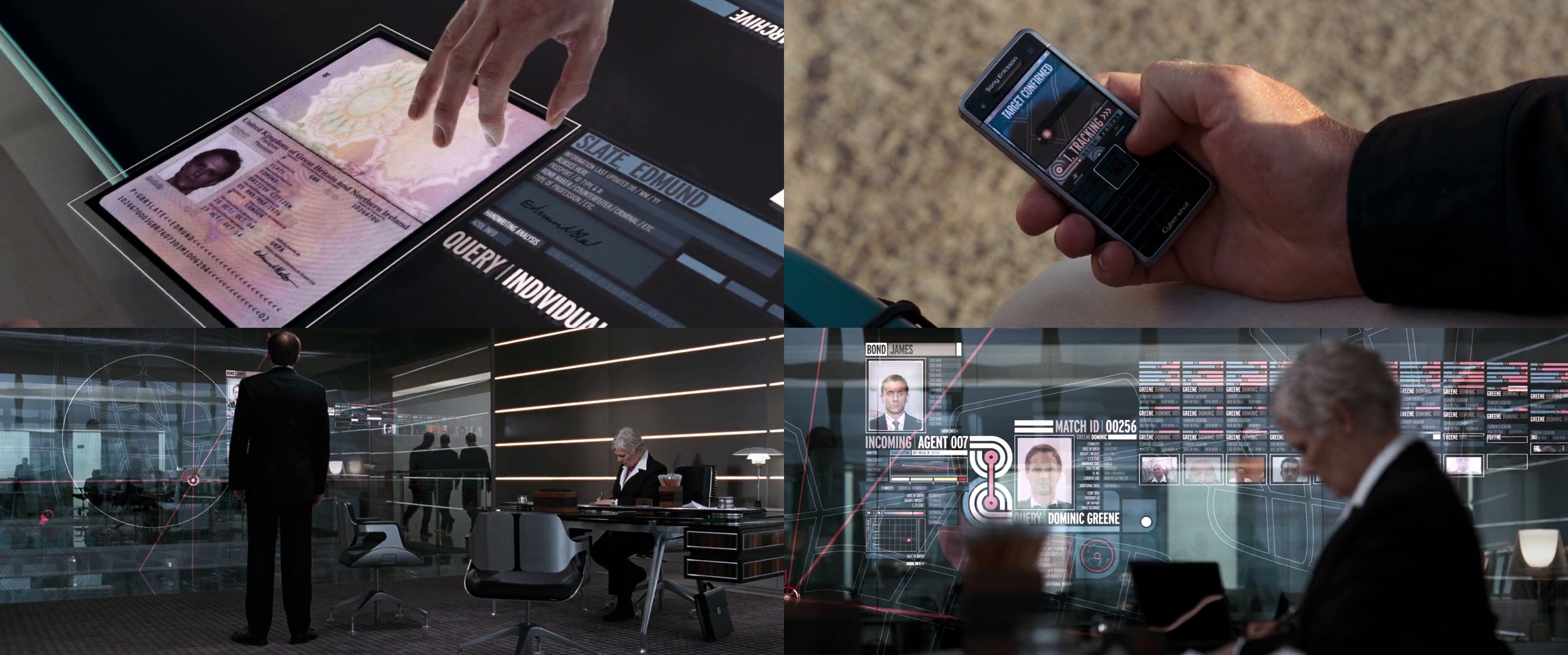
Kirill: What is the process of working with visual effects, particularly with the touch-based interfaces in MI6 office? Do you continue this through the post production stage?
Roberto: I had a very close working relationship with VFX throughout the entire prep and shoot and during the various stages of the DI [digital intermediate] too. I had worked with them on 4 previous films so we know each other pretty well. They had an extensive pre-vis group working full time at Pinewood for all the effects on the film and I spent a lot of time going in there and mapping out shots and sequences. Choosing lenses, moving camera positions, making moves, etc. As for the touch based computer table which was based on real DoD technology we just shot the table and actors to predetermined scripted moves using real placeholders on it which were then converted in post. I did shoot some tests for light levels and image “wrap” around the fingers to establish what would work best to enable us to use the correct illumination values on set that would remain consistent for the final VFX work.
Kirill: How much time did you spend on planning, shooting and editing the aerobatic battle in one of the first sequences (where Bond and M’s bodyguard hang on ropes, jump on crashing platforms and fall through sheets of glass)?
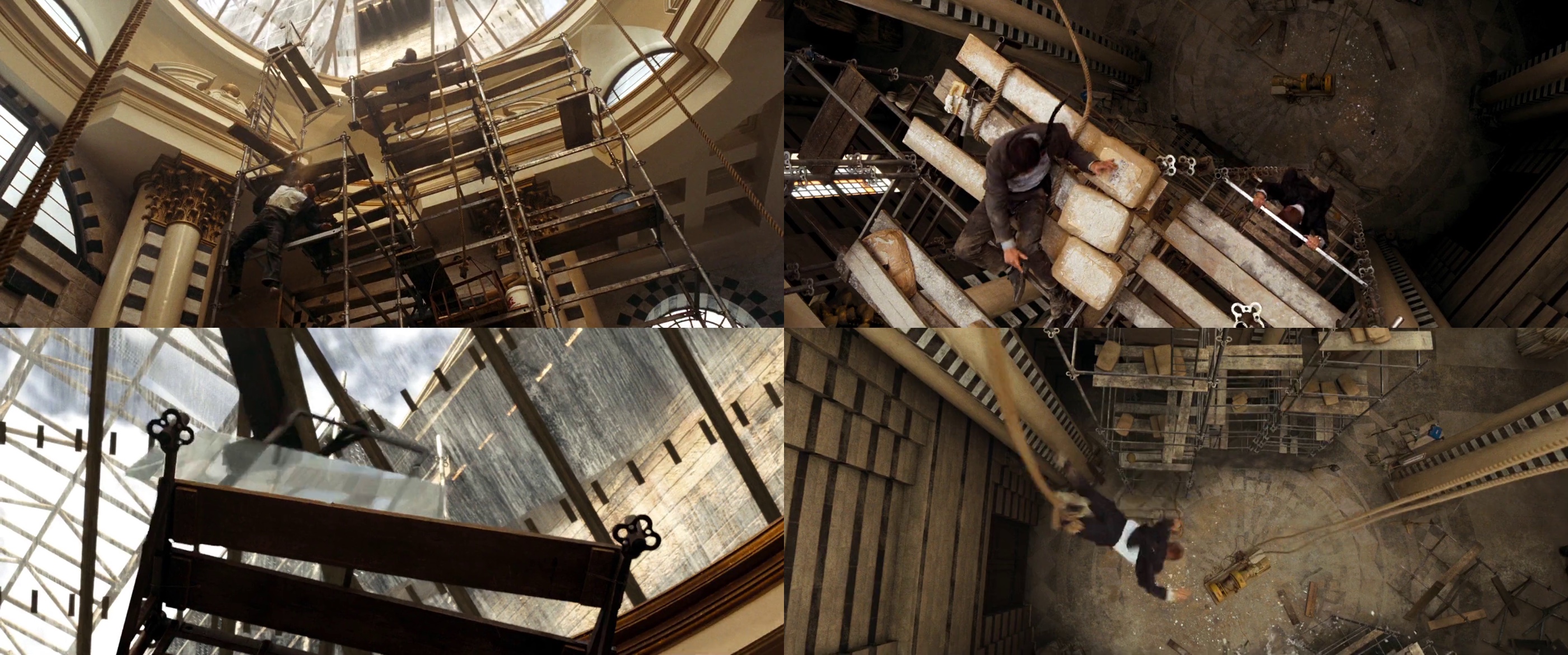
Roberto: That was one of my favorite sequences which I didn’t get to shoot in the end. It was eventually given over to 2nd unit to shoot on stage next to us. In the beginning I did map it out with Marc and the 2nd unit director Dan Bradley, who had a lot of great input on making the scene exciting. I did an initial lighting scheme for the stage to try and match the real Sienese locations. I worked very closely with Shawn O’Dell who DP’d most of the 2nd unit work. I did insist on one segment of the scene which was where 007 and the bad guy fight and fall over the edge of the bell tower and down through the glass dome into the art gallery. I insisted that the camera continue through the dome with the actors and into the fight inside the gallery without cuts. I had seen a scene in Bourne where he jumps off a rooftop in Morocco and through a window into an apartment. I was really wanting the camera to follow him all the way into the room but it cut before it got there. I requested that we do more and continue it in. With VFX and Dan we choreographed a series of 3 shots with CG enhancements to make it do just that. I was very excited by the results. All real actors and sets. From there Dan choreographed with the stunt co-ordinator the fight action spinning around the room on ropes. That was also pre-vised so I could see what it should look like at the end. Marc and I did visit them on the set when we could break away every now and then.
Kirill: What are your thoughts on shooting or post-converting to 3D?
Roberto: I have not shot 3D and not really cared much for it. I’ve seen some good work and some terrible. I think it works best in CG / animation like “Avatar” though “Pina” was really enchanting. As far as post-conversion goes I think it is a great idea if it can be done well. It frees up the camera and lighting to work smaller and more efficiently. That said, it must be agreed that the movie will be converted to 3D after production finishes and not decided upon only then. You would obviously set shots , choose lenses and moves dependent upon that understanding.

And here I’d like to thank Roberto Schaefer once again for this interview. I’m definitely looking forward to seeing more of his work in the future.
What happens to a movie after it is made? How do you preserve a piece of cinematographic history for decades to come? After talking to a variety of creative artists – cinematographers, production designers, art directors and others – it’s time to take a deeper look at the distribution, exhibition, projection and archival side of things. Kyle Westphal is the Chief Projectionist at the Dryden Theatre, George Eastman House and the co-founder and Vice President of the Northwest Chicago Film Society. Kyle has graciously agreed to share his thoughts on the history, present and the future if his craft. In this conversation he talks about the transition to digital projection, finer points of physical and digital archival, the long tail of streaming services and the effects it has on film restoration,and the tumultuous transformation happening in the movie industry in the last decade.
Kirill: Tell us about your background and what drew you into the profession.
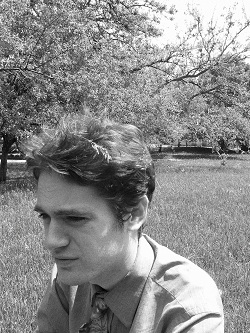 Kyle’s headshot courtesy of R.F. Hall
Kyle’s headshot courtesy of R.F. HallKyle: I’d been interested in film since my early teenage years, and while at that point I wasn’t sure what the outlet would be–making films, being a critic or something else–my options were fairly limited. I lived in Sacramento, which had little industry presence and no cinematheques. My interest at that point, by necessity, was film as text, film as a conveyor of tone, plot, irony and style.
It was not until I was at the University of Chicago that I discovered other, essentially material, ways of relating to film. I became involved with the Documentary Film Group at the University, which has been around since 1941 and is the longest continuously-operating film society in the US. It’s a repertory house which also does second run new releases on the weekends, catering to a broad and diverse college audience. They showed eight movies a week, some of them multiple times, and there was the possibility of becoming an apprentice projectionist for an academic quarter. The projectionist showed us everything – inspecting, threading, running the machine.
After apprenticing for a year and becoming a projectionist, I took on other responsibilities at a few different places around the town. I was becoming interested in the idea that there is more to film than an abstract notion, that it exists as a physical thing, a 35mm motion picture print, and there are a lot of skills and craft involved on that side. The people who work in the depot that send you the print, the courier who ships the print, the curator who books the print for your venue, the inspector, the projectionist–it made me feel connected to film in a way that I didn’t know was possible.
When I decided that I wanted to do this professionally, I felt that I understood fairly well what happens when you get the print and it hits the screen. But the other part–how the print was made in the first place, how you take a negative and make the print from it, how you take disparate nitrate materials and restore fragments of a film to something that resembles the original–seemed the next logical step. And so I came to the George Eastman House and its L. Jeffrey Selznick School of Film Preservation, where you attend lectures on these topics and apprentice the various aspects of an archival institution–cataloging, curation, preservation, projection.
Kirill: You went well beyond taking a print and projecting it in the theater.
Kyle: To an extent, it is still technical. You have to understand what materials you’re working with, what is technically possible in terms of restoring and preserving them. If you’re dealing with analog material in the conventional photo-chemical route–sending a negative to the lab to do the fine grain, dupe negative and print–you have to understand what the lab specializes in, their equipment, and human talent. If you’re talking about digital material, then you’re asking how we can scan the material–a telecine or something higher resolution–and play with it digitally to correct color and density.
It’s also political and cultural. It’s not simply a matter of money falling from the sky, and archives being able to point at a can in their vaults and say, “This is what we’re going to preserve today.” You write grants, maintain a public presence, and make arguments for what is valuable about your collection. You have to have some sense about why these things are culturally important, make those arguments, and have both discretion and discrimination to make a bid for what’s important.
Kirill: What is the level of public interest in repertory theaters?
Kyle: I don’t know if you can talk of there ever being the golden age of repertory programming. In terms of sheer numbers of people having access to and seeing these films, you can say that the 1970s were the “golden age.” There were film societies on every college campus in America, and there were a lot of people showing second run and repertory movies in 16mm prints. It was a widely disseminated and readily available medium, well beyond the college campuses, actually–in churches, union halls, community centers.
On the other hand, you can say that they were dealing with a substandard format, and one that falls outside the modern definition of repertory cinema–brand-new 35mm prints on a big screen with professional equipment. And to play devil’s advocate again, the distribution and demand arising from film societies resulted in a wider circulation of 16mm material. There were things that you could get a 16mm in 1975, and you can’t get a 35mm print, DVD or Blu-ray today. Standards have never been higher, there’s never been more conciousness; studios have never supported 35mm and restoration to the extent they do today, but that does not translate directly into broad availability and range.
When you run a theater, you always wish that the attendance was higher. But if you’re asking whether there is still an enthusiastic audience for repertory, I would say yes. Actually, this whole matter of film and there being a physical thing in front of you–the film strip and light going through opaque emulsion, and the understanding that what you’re seeing is not a result of zeroes and ones, but rather light interacting with physical film–there’s a lot of potential for it to be an experience, a particularly appealing aesthetic, especially in the age when most media consumption is through some digital intermediary.
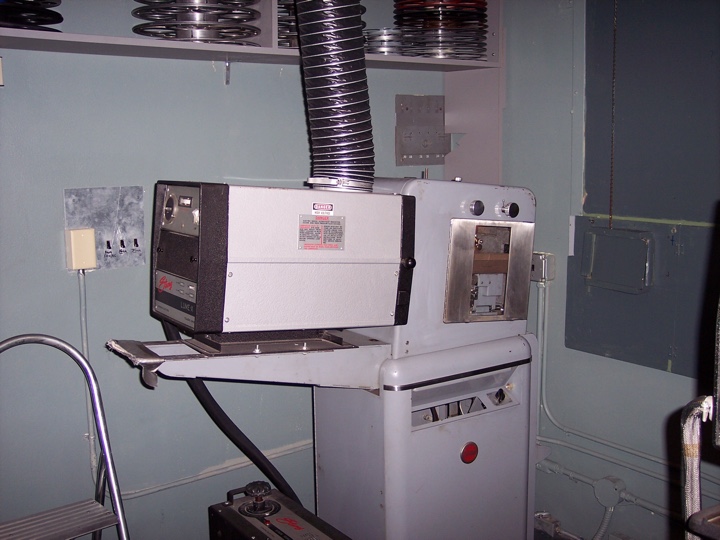
The Eastman 25–a robust, exhibition-grade 16mm projector.
Kirill: What are your thoughts about the transition to digital?
Kyle: It’s a different way of making images, and I don’t want to judge which is doing a better job. And all the talk about high-definition–2K cameras or Blu-ray with 1080 lines of resolution–it’s high definition in relation to standard broadcast and DVD. It’s certainly not higher definition than film.
Grain is not an artifact in film, grain is the film, grain is the image, grain is the way that we’re able to understand what it is we’re seeing. I wish everyone could have the experience of seeing a print made direct off a camera negative with no intermediaries, to see how film stocks of 80 years ago are incredibly luscious and detailed, and have a certain physicality that digital lacks.
This is not to say that digital doesn’t have a place. When you’re shooting in low light, or you’re going for a certain kind of realism or naturalism, without the intervention of so many lights, digital does something. You look at “Public Enemies” or any other recent Michael Mann film, and there’s an aesthetic that is not trying to imitate film, but rather trying to chart a new way that the characters move, a way that cuts make you feel, a way that landscapes have certain solidity – a way that is very distinct from film.
They are different systems with different advantages. I would hate for film to go away. When you look at the history of the 20th century, it’s the history of film, it’s the history of not only narrative films, but all the ways that people expressed themselves–whether it be home movies, industrial or sponsored films, newsreels, television footage shot on 16mm. There’s a beautiful idea that a century has a medium tied to it, but then there’s obsolescence in film as we’re in 21st century.
Film, of course, does have a role in the 21st century. If you’re talking about archival concerns, digital is not a proven thing. The idea that I can have a negative on modern polyester stock, put it in a can in a climate-controlled vault with minimal fluctuations in humidity and temperature, and I can reasonably expect that if I take this film out of a can in ten or twenty years, it’s going to be stable. But for anyone who has tried to recover information from an old hard drive or an old floppy disk, the very idea of archiving things digitally–even though it is inherently unstable and its features are often dictated by consumer demand rather than long-term storage concerns–is a troubling thing. There’s a place for film because we understand what it is and what it does well. There may be a time when digital is better, but at the moment you’re always looking at migration, compatibility and proprietary file formats–things that are obstacles to long-term access in a way that should not be taken lightly.
Kirill: So you’re talking about all aspects of film, shooting, projecting, and archiving?
Kyle: It’s a complicated question. There are certain reasons why a cinematographer would want to shoot digital, and I don’t begrudge them needing and liking those tools. I don’t take a line in the sand that I won’t see a film shot digitally, but I’ll be honest and say that they don’t move me as much. We sponsored a Home Movie Day last week, where people bring old super-8 or 16mm old movies that they shot, which is not the same as Hi-8 or VHS tapes. There’s a different quality to the image, a different physicality to the image being on film. I will admit that this has an emotional pull on me that video does not, or does not yet.
At the same time, who am I to say that people shouldn’t shoot on digital? Who am I to say that post-production technicians shouldn’t avail themselves of digital workflows or digital intermediates that are simply facts in the industry? In that sense, projectionists can’t stand in front of the tide of progress. But if you talk to cinematographers, most of them will also say that they want to have film as an option for a particular ‘film look’ that’s valuable, a look that is more valuable than what market forces might appear to make it.
In terms of projection, I am more staunchly in favor of film projection simply because digital projection is not very well understood. We’ve been going through a very chaotic transition over the few past years, especially since “Avatar.”
The studios have been pushing exhibitors to convert to digital projection, and there’s a level at which this is good, the level where previously digital projection had no standards. If you were running a film festival or a cinematheque, and you were dealing with independent filmmakers, this was a real problem. This has been a long saga and someone has always been on the short end. There was decades-long period of time where if you wanted your film to be seen and distributed, you had to make a 35mm print. You might have shot on 16mm, you might have shot on super-8 or on video, and the expense of going to a 35mm duplicate negative or internegative, and making a release print was a substantial barrier.
But the tide turning in the last decade placed the responsibility on exhibitors to meet the need of filmmakers. If you’re running a film festival, especially a regional one that is not industry-affiliated, truly dealing one-on-one with independent film makers, you’ll get requests to show it on DVD, on Blu-ray, on DVCAM, on BetaSP, on DigiBeta, on HDCam, from a hard drive, from a MacBook–I’ve dealt with all of these. And to some extent it was very chaotic and unsustainable: film was too expensive for filmmakers, but getting all the technical capabilities was too expensive for all but the wealthiest venues. There was this unproductive standstill.
There’s an extent to which DCP (Digital Cinema Package), which is what all the studios have signed on to and pushed, is good. You’re not dealing with different people who’re saying, “I have a tape,” “I have a disc,” “I have something I’ve burned on my computer, take it, it won’t skip” and that’s good. The problem is in how it was implemented as a closed system, and in a way that has not been talked about enough. If you ask the person on the street “What are you seeing when you go to a movie theater?,” most of them assume it’s already digital. Most would genuinely think that you go into the projection booth and you put a DVD on screen, using the same kind of consumer products that they are familiar with.
The fact of the matter is that film is great because it’s a very open standard. If your film is manufactured with non-standard perforation, you’re out of luck, but 35mm has been an international standard going back decades. I can send a print to China, someone in Argentina can send a print to me, it can go to Africa, to Europe, to all corners of the United States, and it’s standard. I can put it in a projector, and while there might be some quirks in the lab processing and there might be some sound system that is more prevalent in one country than another, by and large if you give me a 35mm print in good condition, I can project it. I can project it as many times as I want, and I can project it whenever I want. I can go into the projection booth at 4 am, and if it’s my inclination to thread up a print and watch it just for myself, I can.
This is not the case with digital. It’s not our technology, it’s something very closed. It doesn’t necessarily have to be, as you can make and distribute DCP in an unencrypted way that doesn’t need keys. Right now the studios send you a hard drive and it uploads to a local server in your multiplex theater, where you have a repository of files from different hard drives, and eventually they get wiped off and you send back the hard drive. The idea is later to do all this via a satellite network, eliminating the physical intermediary of a hard drive. And to play these files you need keys from the studio or distributor. A key can be as simple as accessing the file, or as extreme as telling you how many times you can show the file and when you can show it. It can say that your projector is going to shut down after a certain time code, it’s a kind of digital rights management (DRM) on steroids.
From the archival perspective this is not very good. We can acquire a print. We can put that print in a can on a shelf, we can pull it out ten years later and it was more or less the same way as we left it and we can thread it up. We can catalogue it and do all the things to maintain the collection. If you send me a hard drive and I put it on a shelf, but I don’t have the key to open it, or the key that I have only allows access until December 31, 2012, then it’s a bunch of chips after that and it doesn’t mean anything.
There have been horror stories at film festivals recently of server errors, files not being played back properly, files not being able to be accessed even though the studio gave you a key – well, there might be a problem with the key, or a server problem on their end. And all of a sudden instead of being able to take the film and have a very physical relationship with it, being able to wind through it and evaluate what’s wrong with it and what needs to be done to make it go through a projector safely, now you have to call up the IT division of the studio. And maybe you’re doing the screening on the weekend and there’s no one at the IT division, or you’re one out of two-hundred calls, or they’ve outsourced to a third-party company that doesn’t understand your relationship with this distributor and how important it is that you really need to get this key to open the file for your very important festival screening.
There’s a significant way in which transitioning to digital in terms of exhibition is a substantial reduction of freedom for the exhibitor as a whole, not just the projectionist.
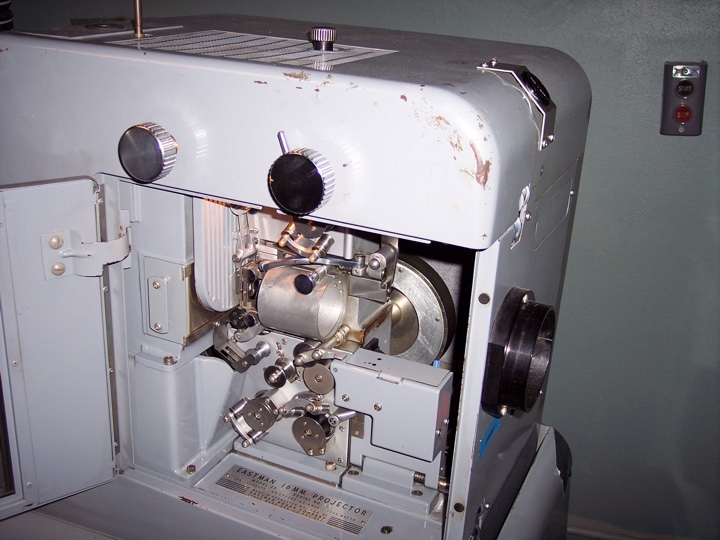
Another view of the Eastman 25 16mm projector.
Kirill: Does this also marginalize the craft of operating a film projector?
Kyle: There is a level of craft that is invisible and not appreciated. The old adage says that you never know about the projectionist until something goes wrong, you’re not conscious that there’s someone in the booth and that there’s labor going on, unless the film breaks. In the archival field, we say that film is human-eye readable. Let’s say in 200 years from now there’s no one alive who’s ever threaded up a projector. They can still open up a can and wind through a reel of film, and they can see that there’s data there. What if you dust off a hard drive 200 years from now and there’s some proprietary format–what can you do with that?
In a way, the problems aren’t localized. I’m winding through the film and I see a bad splice that needs to be corrected, or an area with a scratch, or a point with some adhesive on the film. When I’m projecting that film that I’ve wound through, I can look at the screen and see the manifestation of that thing that I noted earlier. A server error or a data blip doesn’t have that relationship. You can listen to a vinyl record, and you look at it and see a scratch, and later hear the artifact of that during the playback. This is not to say that all films and records should be scratched, or should have some mark that says that a human being touched it – it’s great to see a film in perfect condition.
But there’s a way to understand what is in front of us. I have a bad print, but it’s the only print in the United States of a title, and I’ve got it from a private collector, or our archive happens to have the only copy. It’s not the best copy, it’s faded, it’s splicey, but it’s all that there is. I can go up in front of the audience and say that there’s this physical artifact with extraordinary material history, and you’re going to see the reflection of that on the screen, some fading, points where the image jumps – because it was used. And the fact of the matter is that a digital file doesn’t have that kind of trail, and the problems that arise with digital are not human problems. They are human problems on the level that we need to build a better server and a better IT network. But on the level of, How did a person handle this, How did they treat it and to what extent is what we see now an accumulation of everyone that ever touched it, that is not the case.
Kirill: As more films are done completely in digital, and studios release the back catalogues in Blu-ray format, do you see archives transitioning to purely digital format in the future?
Kyle: It’s an interesting question, because even though movies are done digitally, studios are still doing film for protection. They’re still doing separation masters of a color film. Color negative, although it’s better than it used to be, still has fading characteristics that black-and-white negatives don’t have. And to protect these color assets–which is what they are to the studios–they do separations along the color spectrum. And that is still being done on film, as there is understanding that at some point there might be a robust, migration-proof, hard drive crash-proof way of archiving digitally, but for the moment film is not proprietary. Film does not require you to renew your license.
I don’t want to come off as saying that digital is all bad. There are so many ways in which digital is important, let’s be honest. If I want the work of this archive, or any archive, to be shared, if the studio wants its work to be disseminated, being able to show it as a 35mm print is very specialized thing now. If we’re spending all of this money to make a print, and it goes out, we don’t want to send it to a multiplex where it’s going to be all spliced together and put on a platter system and projected without there being anyone overseeing the machine. There’s a relative handful of venues that have the ability and that care enough to treat prints well.
If we don’t make films available digitally, the broad majority of people won’t be able to see them. They won’t be able to go to a brick-and-mortar store or an online store and purchase a DVD or Blu-ray version. Let’s face it–there are a lot of people who don’t live in a town that has a cinematheque, that don’t live in a place where someone finds out about a new print struck by the Library of Congress or the George Eastman House and says “I must show it.” If the only way a person can see something is through a digital copy, I don’t say that this person has to be a purist and see it on film. And at the same time, there’s a level on which the DVD and Blu-ray market opened up studio catalogues, spurring a great deal of preservation. There’s been more preservation in the last decade than in any decade before it. It happened because these assets became exploitable again, because we got into higher resolution formats.
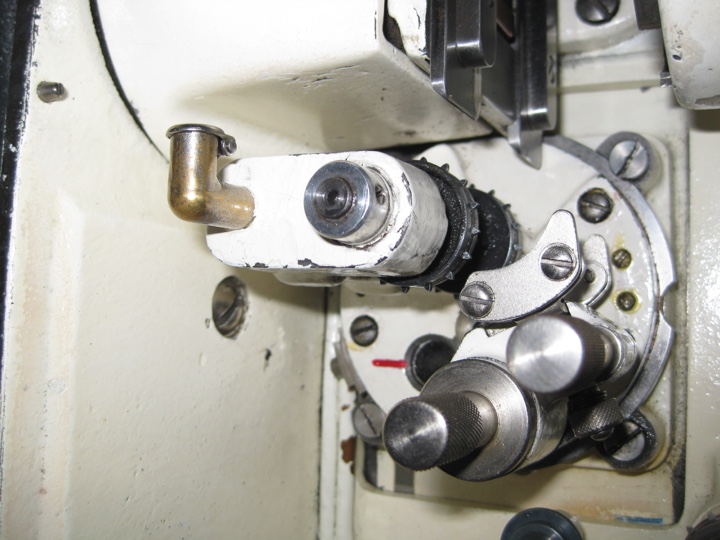
Intermittent sprocket on the Century C 35mm projector.
Kirill: Are you talking about taking existing material and providing it in digital format, or going all the way back to restore material that was not publicly available before?
Kyle: You might have a film without a surviving original camera negative. You might have a mediocre dupe negative. Or perhaps two dupe negatives where one is missing a scene, and you have to go to print to get a scene or talk to another archive to get material and recombine it. Or you might have a nitrate negative that is starting to decompose and you have to transfer that information to another film stock as polyester protection material so it will endure.
And in all cases the gold standard is film, the gold standard where you’re not losing data, where you’re not working with proprietary formats. It was the case that in 1980s as VHS was coming into its own that the studio could take any print that they had off the shelf, do a quick and dirty transfer, and put it on VHS. There was a clamoring for content on VHS, and the quality of the material you selected for transfer did not matter–a print, a negative or something else. And for the most part there wasn’t any critical thought towards, What is the ideal element, What is the best surviving material on this film.
As consumer formats matured, and you had more high-resolution format such as DVD and Blu-ray, just taking any old transfer off the shelf wasn’t standard operating procedure anymore. In many cases, ironically, the only way to get digital assets and put them on a disc in a box that you can buy at Target, Best Buy or Amazon–to do it efficiently and correctly, to yield the best image that is sufficient for those formats–is to go back to the film elements, to go back and do the full photo-chemical restoration job, to go back and set right the mistakes of the past.
Kirill: Because it has the full level of details?
Kyle: Exactly. Because by definition you cannot improve upon the camera negative. That’s literally the emulsion that was exposed when the film went through the camera gate. You can’t get anything better than that, and it’s often the case that preservation material from forty years ago– stuff that was film-to-film transfer, the only way to do preservation back then–might have used a lab with different set of lenses, or a less sophisticated printer. There are modern techniques that can yield better preservation material. So even though you may already have a preservation negative, it makes sense to go back to the earliest, most original element.
It makes sense to go back and say “Can we do a better job, can we make a better transfer” with the view that we’re going to have, on the one hand, better protection material on film, and on the other hand, a better-looking digital asset for consumption by a mass audience.
Kirill: Is the growing back catalogue a by-product of the ongoing restoration process?
Kyle: One is not really the by-product of another. They’re working together. The studios could not do film preservation to the extent they have if there wasn’t a bottom line reason to do it. They’re for-profit corporations, and ultimately if it makes sense to return to the camera negative of “The Wizard of Oz” because you have to put out a Blu-ray of it, and the existing transfer is good but you can improve it with modern technology, then you do that and you also create a film backup. But at the same time these things are incredibly intertwined.
You need the consumer formats to be able to fund these preservation efforts, but you also cannot have your lucrative consumer formats unless you’re really taking care of your assets and unless you’re doing the right thing by them, unless you’re constantly revisiting them and asking “Can we improve this?”
And luckily, it’s not as if the only things being restored are the things that you see on DVD. DVD has reached a point where it’s matured, where the back catalogue releases are not quite as steady as they once were because we’re dealing with films that are in many cases not A-list catalogue titles. I think a lot of them are better in terms of what they mean to me as a film goer, in terms of what I cherish about film history. There are still plenty of films–thousands of films–that are not available on DVD and Blu-ray, but in terms of the titles that are available and are revisited, that are the evergreens for the studios, where they can release a copy of “The Ten Commandments” or “Gone With the Wind” or “The Searchers” or “Star Wars” over and over again.
That is also able to fund more marginal titles, to fund the things that studio recognizes that they have an obligation to preserve. They’ve made this. As a cultural entity, and as a corporate entity, this is an asset that can wait in the vault for future exploitation. If they spend $20K now, they can exploit it for another 100 years even if they decide not to exploit it tomorrow.
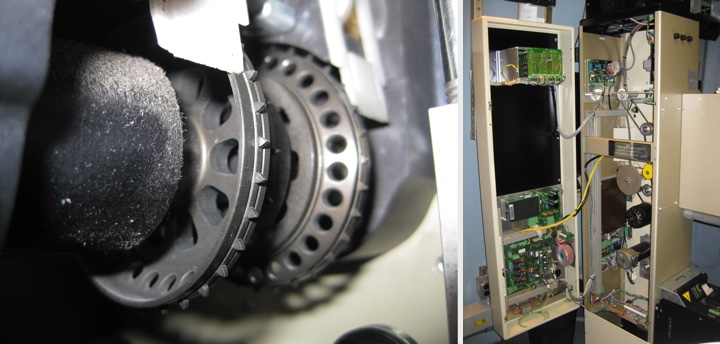
On left – intermittent sprocket on the Kinoton FP38E 35mm/16mm projector. On right – the electronically-regulated interior of the Kinoton FP38E 35mm/16mm projector.
Kirill: Does this long tail feed back into repertory theaters where people expect to discover and rediscover movies?
Kyle: Yes, and a lot of repertory programming is possible because of restoration efforts and these efforts are part of this long tail. At the same time, I will say that repertory tends to be the poor stepchild, not through the fault of anyone really, but simply because if you’re taking about doing a high quality scan of an original negative in 2K, 4K, 6K or 8K, you want to return to the most original element, to the original camera negative if possible, or the closest thing and to make a new preservation negative. Video transfers are done from camera negatives or interpositives, not prints.
In terms of actually making a print, a print has a very limited life. A studio can restore a title, or an archive can restore a title, and the ultimate goal is a new polyester protection negative. The new negative becomes the element used for all future needs, including scanning and transfer. If you’re following best practices, you make a print from your negative. That’s the best way to check your negative–see if it needs further correction, whether a decent print can be made from it at all. But actually making that print–what’s it worth? Its only real use is as an exhibition medium and there are only a handful of venues interested in exhibiting it. You’ve done your due diligence, you’ve made preservation material and a digital asset that can be used for future exploitation, and you’re going over budget at your studio and you’re saying, “Do we want to spend thousands of dollars to make a print that five people are going to show, that’s going to sit in the vault and never going to be seen?” In some ways, prints are the most neglected part.
You’re making a new print, and that’s great, but the only way you’re going to earn your investment back is by showing it or by renting it out over and over again. Frankly, you will most likely have a print that’s ruined and damaged before you can make your investment back. You’re not talking about a wide release, but something that’s going to art houses, something that’s not playing continuously but is just a one night stand at a venue in Chicago or St Louis. It passes through 40 different projection booths by the time you make your money back. You very well might not make your money back as it could be damaged the third time someone shows it.
Fortunately from the archival point of view, we’re not so bottomline-oriented. Politically, as an institution, we feel there’s a value in making these new prints. We’re not saying, “We’re not going to make a print or preservation because we expect that only five people will want to borrow the print”. We have a different mandate and different goals, and our funding stream is different, and so we’re lucky enough to do that.
Kirill: Do you see the studios experimenting in exposing the long tail of the content through Internet streaming services such as Netflix or Amazon, hoping to return their investment in 10-15 years?
Kyle: Certainly the studios are very interested in streaming and VOD (Video on Demand) right now, and certainly other institutions like archives are interested in streaming content that can be made available through these new platforms. Theatrical revenue is declining, home video is declining and there has to be a new way to make this equation work. There are things that unceremoniously went up on Netflix instant viewing that have never been available on home video, that are very difficult to obtain as a 35mm or 16mm print.
But the fact of the matter is that streaming has its limitations. Because of the bandwidth that most people are using, because of the quality of connection that most people have, streaming is right now at a point where the quality of your source is not so paramount, and whereas a studio will have to go back to the camera negative or the earliest surviving material to master a decent Blu-ray, it’s not at all uncommon to pull off the transfer from the shelf done twenty or thirty years ago to meet the streaming demands. Most likely the compression and the rest of artifacting that’s inherent in streaming right now due to the current IT network make it not so important. If the studio can just pull out a tape that was mastered twenty years ago, that isn’t especially helping preservation. It’s good for cinephiles who are rabid to see this film and don’t care about the quality, and in a way don’t care if what they’re doing is sustainable…
If the studio is getting revenue from streaming, that’s great, but that doesn’t send the same message as all the people coming in to see a print, deciding to take time out of their day to pay admission and to come into a theater, and this theater is telling us that they want to bring the print back and show it again. It doesn’t have the same ripple effect of positive action and encouragement right now, but it doesn’t mean that it won’t ever have that effect as streaming becomes more sophisticated.
As bandwidth becomes less of an issue and high-speed Internet becomes standardized in a way that it’s not now, and the standards for streaming go up, maybe it will be the case where people will say, “This copy is unacceptable,” and people will have to go back and do preservation and restoration so that they have a decent copy to stream. So long as the material is looked after in a way that allows the people who own it understand that there is value in it, that there is demand for it, that it is sensible to work on it, preserve it and conserve it, ultimately that’s good. I would prefer, of course, for it to be seen on film because that’s how it was seen, and if you’re watching the film on your laptop, it could be an HD copy of it, but it’s still your laptop, it’s still not the same as being somewhere and having this physical thing going in front of beam of light. It’s just fundamentally, aesthetically, materially different.
Kirill: My impression is that the rise of VHS in the 1980s marked the end of the movie theaters “owning” the experience of watching movies. The advent of DVD and Blu-ray is now combined with the push from TV manufacturers that try to lure the consumer back into his living room with widescreen, high definition and 3D experiences. Do you see the movie creators, exhibitiors, and projectionists “fighting back” to get the movie goers back into the theaters?
Kyle: There’s not one argument, there’s not one silver bullet – there are people who say, “Yes, i like seeing a film with an audience but at the same time i don’t like seeing it when the audience spilled their cola all over the floor and there’s a screaming child, and it’s a better experience when I’m watching it at home on my HDTV through my Blu-ray”.
Earlier I brought up the issue of vinyl and how that’s had something of a resurgence. The same thing is possible with film. I think there is a hunger, especially among my generation, for this physical media. It might not be all that apparent until it’s almost gone, which is to say that we might not appreciate it until everything is essentially just a file in the cloud. But as you can see, we’re living in the age of iTunes and concurrently there are people who are now fanatical about vinyl. If you told me ten years ago that there’s going to be a new record store, and it’s going to open up and it will mostly sell vinyl, and people will pay more for vinyl than they ever did for a CD, and there’ll be this real aficionado appreciation of “I’m getting something and it’s not just a file on my iPod, or a file in my cloud or a file in my Ultraviolet locker, but I have this thing in front of me.” I think that that appetite can certainly be there with film, but I also think that at the same time it’s not a one-pronged thing.
The audience thing is important, and I think that there is a longing for community that shouldn’t be discounted. Programmers and theater managers and projectionists who are, most probably, the most staunchly pro-film people in the country just by the basis of their job, have to interface with video every day. They have to preview films on a DVD copy, decide whether to show it. I’m not opposed to the home media–it’s convenient, it represents certain advantages over seeing something communally. But at the same time I think there is the sense that people do want to go see something, that they do want to experience it with other people in a communal space.
And there is something romantic about movies not just as celluloid and not just as an experience, but as a totality. This is to say that if the revenue was really in streaming, or the revenue was really in home video, and the studios were able to totally cut out the theatrical and just say that everything is going to go direct-to-video because we can control this more, or this is just a more profitable way of doing it, then this would happen. We’ve had home video for decades now, and how prestigious are direct-to-video releases? There’s still a media consciousness about something “opening in theaters next week,” and there’s a level at which it’s news, and it’s reviewed online and in newspapers and on television, and there’s a new movie opening and this is a cultural event in a way that is very difficult to imagine when you say, “We have assembled this great cast, and we have this great director and starting tomorrow you can stream it.” It’s not a cultural thing in the same way, and that’s important.
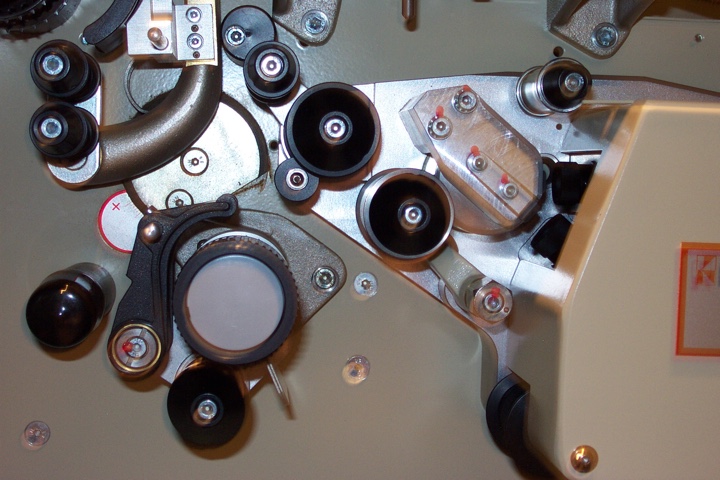
A modern reverse scan Dolby Digital sound head on the Kinoton FP38E 35mm/16mm projector.
Kirill: What are your thoughts on the avalanche of 3D productions that came after the enormous box office success of “Avatar”?
Kyle: As someone who is happy to spend a day watching silent black-and-white films that are definitely 2D and lack a lot of other things if you’re just going by that kind of metric, I don’t want to say that cinema was missing something before 3D. There’s an extraordinary film made by Peter Kubelka called “Arnulf Rainer” that is the purest film you can imagine. The only components of it are black frames and white frames, and the only sound is either the black of no sound or the white noise of the soundtrack, and the film is about the infinite variations of these, and how it can create rhythm and how it can be moving. And that’s an extraordinary film, and there are plenty of extraordinary films that are black-and-white, there are plenty of extraordinary films in color, there are plenty of ones that don’t have sound, and it’s a different kind of medium.
At the same time I’m reluctant to say that 3D adds nothing. Have I ever seen 3D that made me think, “My God, I can never go back to watching a 2D film” or “This experience is essential in 3D”? I haven’t, but that’s not to say that it won’t come along. But new technology doesn’t make old experiences obsolete or emotionally invalid.
In terms of the 3D craze, one thing that does need to be understood is the extent to which 3D is the major justification to the conversion to digital projection. From an exhibitor’s point of view, what are the advantages that you gain with digital? You don’t have to deal with prints, you don’t have to pay a projectionist – but frankly they make up such a minor portion of a theater’s balance sheet, that these savings in no way exceed the cost of going digital.
Kirill: I’ve heard the figure of one million dollars that the studios are saving on average by doing digital projection.
Kyle: This is what I’m getting at. It makes sense for the studios. If suddenly you don’t have to make 3,000 prints of something and just duplicate a hard drive – and eventually beam it from a huge server via satellite – this is a significant savings for the studios. But is there something in digital projection that makes sense for an exhibitor to spend $60-100K per screen? Is the audience going to increase that much, and is the expense going to be counterbalanced? The answer is frankly no, that a lot of people don’t really care whether your film is projected on film or digitally.
But then you start saying that this is only available in digital 3D. And look at all the money “Avatar” made in digital 3D. Just think: when you have the next “Avatar,” do you want to be the theater that converted to digital and has a full house, or do you want to be the one showing it in 2D on 35mm to an empty house? So in a lot of ways 3D has that function of legitimizing digital and also making it necessary for exhibitors.
Of course, who knows whether there will be another “Avatar,” who knows whether the next huge blockbuster will be 3D? The studios obviously would like it to be. The equipment manufacturers would like it to be in 3D. But is audience interest in 3D sustainable? I’m sure we both read figures about how the share of screens that make up the film gross in 3D is declining, which is to say people are still going to see the film, but are opting to spend less money and not wear the glasses. That’s a scenario that’s very bad for the 3D equipment manufacturers and the studios.
Kirill: Doesn’t that go against your point that exhibitors are not going to maintain multiple variants of the projection equipment?
Kyle: Let’s talk about this from a few points of view. Logistically speaking, the very worst scenario if you have to make prints is to have 1,500 play dates that are prints and 1,500 play dates that are digital. If all 3,000 were film or all 3,000 were digital, you can have an economy of scale. You still have an economy of scale at the level of the major production, but on the distribution side you have to keep two production lines up and running that aren’t really compatible.
And that’s not a good solution, if the equilibrium is 50% prints and 50% digital, then you have a system that is not efficient at all, and which is probably more expensive than what was there in the first place with 35mm. And to assure that there is full or reasonably full conversion, the studios have instituted the Virtual Print Fee where the studios grant you a credit that helps you upgrade and there’s a discount on future bookings. And often there’s a stipulation tied up that you discard your film equipment, that your 35mm projector that might have been in your theater for thirty or forty years is disassembled, is thrown in the dumpster and made inoperable.
So when your digital projector breaks, you can’t go back and say that it would be better from your point of view to just go back to film. Five years down the line no one wants to be dealing with film, no one wants the possibility that people will be able to say, “You know what, this is something that we shouldn’t have discarded”. There has to be a complete ideological and mechanical transformation for the conversion to make sense.
Kirill: How far along is the digital conversion across the large exhibitors, and how reliable has the new equipment proven out to be so far?
Kyle: The digital transition has sped up in the last two years largely because there was a period when standards were not in place, when equipment was not reliable and largely because financing was not worked out. The last decade was filled with proclamations that film will be dead next year, all theaters will be digital next year – I remember this going back to 2001 or so. And it never quite happened that quickly, because the exhibitors looked at it and said, “If we’re going to spend $100,000 per screen, what are we getting out of it, and is there any conceivable reason why we should do this, and where is our cashflow going to come from?”
It has been a long time coming, it’s been slow and the momentum is building. The conversion figures are changing every week, and I would say that right now it’s approximately 50%, and you’re never going to get a 100% compliance. There are some regional chains, some independent houses, some art houses that are simply not capitalized sufficiently to be able to convert. If the customer base for a print is so small, your costs are going to go up and it essentially becomes a niche, not cost-efficient product.
And there will be a day–no one knows when–when as a distributor you stand on a financially better footing by writing off exhibitors who aren’t able to afford to convert. Most likely if they can’t afford to convert to digital, they don’t have very many admissions, they’re in a very low population area, and ultimately your returns for “Fast Five” or “Captain America” don’t hinge on a theater in South Dakota shutting down or not–they’re a rounding error, more or less. And so necessarily there will be a point before 100% conversion where it’s simply decided that these film exhibitors are a drag on the economy of film distribution–and that will be a day of transition, to put it euphemistically.
In terms of the reliability of digital equipment, the problem from my point of view is that we’re really operating in uncharted waters. Up in the Dryden booth where I work, we have projectors that were built in 1937. They’ve been installed and running continuously since 1951, they’re Century Model Cs. There’s a level at which, for most of the cinema’s life, projection equipment was heavy industrial stuff with a very long lifespan, relatively simple maintenance regimes and a wide availability of spare parts. These machines kept on going and could be used for decades. A theater would close and its assets would be resold to another theater or another chain, refurbished, retrofitted, reused–for years and years and years.
And quite simply, digital technology has not proven to have that kind of longevity. How many laptops have you had in the last decade? How many times have you gotten a new drive? How many ways have you stored your files? And there’s a sense in which this equilibrium cannot exist because the economics of technology as we experience them now are about upgrading, getting more memory, getting a more robust operating system, over and over again. This is by design. You use your laptop for 3 years and then you’re embarrassed to even have it, you have to upgrade.
Kirill: Are you talking about home machines or the projection equipment at big houses?
Kyle: I’m saying that the whole paradigm has shifted, a convergence. Industry is using consumer equipment with minimal modification. If you take out home use of computer electronics and you just look at business use, your time span is a bit longer, but businesses are always upgrading their networks, they’re always getting new machines, they always have to get something else to be able to run new software and to be able to take advantage of it. And the idea that someone can make a digital projector that will still be working in 60 years, that will have a stable platform, stable file format, stable compatibility, and that we’re not going to say that we will find a new codec, a new way to compress the data more efficiently, a better colorspace…
Technology is going to go there, and quite simply 35mm was lucky to have all of the developments on the level of emulsions, film stocks, laboratory practice and auxiliary equipment. But ultimately you send a print to a theater, and I can take a nitrate print from 100 years ago, and assuming it’s in good shape, I can put it on our projector. I can take an acetate print from 50 years ago, and if it’s in good shape and I’ve repaired it, I can put it on the projector. I can take a modern print and put it on the projector. I can avail myself of these technological advancements using equipment that needs very few upgrades and a very limited maintenance regime. It is heavily backwards-compatible.
Our experience with computers and modern consumer electronics, whether we’re using them at home or business simply contradicts this idea that we can have this kind of industrial strength technology that lasts without a constant stream of upgrades.
Kirill: So effectively your doomsday scenario from the archival perspective is not being able to take a digital file in 50 years from now and be able to find a projection system to play it.
Kyle: Not even a projection system. If want to edit it, if you want to find a way to stream it through whatever system you’ve set up in 50 years from now–how are you going to be able to read that file, and do you know that you can read that file? Has the hard drive been corrupted, how many backup copies do you have, are you migrating the data? When a whole company’s identity and profit system is based on the idea that we’re developing a file format, and it’s going to work with our tapes or the software we have, and we’re going to have a proprietary format – what if that company goes under? What if you upgrade to a different operating system that is not compatible?
There’s an extent to which archivally we really cannot know whether these zeroes and ones are going to be read in the same way. We can take precautions, we can use open source, we can steer away from proprietary formats, we can try to be stable in what we do. But if you talk to people in post-production, you’re talking about bits and pieces taken from various software systems where you might edit sound using this program, we might do color correction using that program–and we might have digital data in all of these ways that are disparate and might not be compatible, or might make sense with the machine we have right now. But if we try to plug it in later, or try to take stuff off the hard drive, we might not be able to do this, and probably won’t be able to do this.
The real test of this is people thinking about their own relation to technology over the last decade. Can you look at those things that you’ve saved on a floppy disk or a zip disk? Can you look at those things that you’ve typed in Microsoft Works? Can you access these files, can you access your hard drive from three hard drives ago? And if the answer is no, that should give us pause.
Kirill: It’s interesting that you’re talking beyond the fleeting moment of the latest movie releases, and are thinking about how we’re going to watch “Avatar” a 100 years from now.
Kyle: If the most sensible way, economically, is to screen “Avatar” digitally, and if it really, truly makes sense for exhibitor, distributor, and the producer, if that’s where the industry is going, I’m not going to picket at AMC and say, “You must show film, you must not show digital.” Digital technology has a place today because that’s what people are interested in, that’s what the producers are excited about. The idea that you can do digital 3D stimulates James Cameron, stimulates a lot of film goers and stimulates a lot of studio executives.
I don’t object to that. But if we’re talking about the posterity of this, if we’re talking about being guardians of this culture and keeping it, we need to think longer term and we need to think, Will this great (or mediocre) technology today be a workable technology tomorrow? And we also have to be honest with ourselves to say that we don’t know all the time.
So in many ways the most sensible thing for digital media is to keep digital backup, to keep your data as data, but also have some kind of physical backup, to have it on film, to have it on tape, to have it on these proven analog mediums that we understand and that are relatively stable from the point of the view of access.
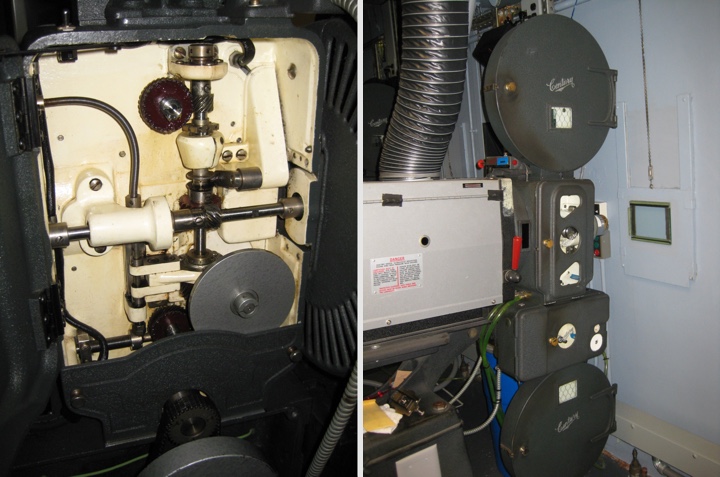
On left – the heavily mechanical (and greasy!) interior of a Century C 35mm projector. On right – flammable nitrate films can be projected on the Century C 35mm projector with proper enclosures.
And here I’d like to thank Rebecca Hall at Northwest Chicago Film Society for helping me get in touch with Kyle, and of course Kyle Westphal for the incredibly detailed look at the effects of digital conversion on cinema exhibition and projection. Kyle’s headshot is courtesy of R.F. Hall, and all the rest of the images were graciously provided by Kyle.
“Midnight in Paris” is the latest production written and directed by Woody Allen. A young couple, portrayed by Owen Wilson and Rachel McAdams, travels to Paris on the eve of their wedding. As Owen’s character falls in love with the city, the movie takes an unexpected turn, exploring a nostalgic – and at times over-idealized – fantasy that a life different from ours would be much better. The opening sequence of the movie, with the camera lingering lazily on stunning Parisian vistas, sets the visual tone for the entire movie, with fantastic performances from a star-studded cast.
Anne Seibel is responsible for the flawlessly executed production design of the movie. Over the last couple of decades she has worked on numerous productions, from “Marie Antoinette” to “Munich”, from “Swordfish” to “The Happening”. I am quite delighted that Anne has agreed to answer a few questions I had about her work on the movie and her craft in general.
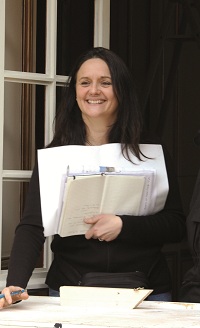 Kirill: Can you tell us a little bit about yourself and your background?
Kirill: Can you tell us a little bit about yourself and your background?
Anne: I studied in an architecture school, and I always liked doing art props for dance shows and family productions. My family was not in the movie business, but rather in science and medicine, and I went to study architecture. One day a friend of my parents offered to take me to a movie set, and I was very curious to see what happens during the shoot. There I realized there was an entire team of people doing what I was doing at home – making the sets – and it attracted me. I realized that with my background in architecture I can be part of such a team.
After finishing the school I had a chance encounter with someone working in the movie business, and when he asked me what I wanted to do, I told him that I wanted to do sets for movies. He offered me a job to draw a few sets for the fund-raising presentation. After working there and meeting a few people I have decided to call ten best designers in France to get an assistant position.
And then one day, I met a big designer named Serge Douy at the bar and he told me that he has a small job to mirror an english crew coming to Paris to film a movie, and he needs someone who speaks english. I asked which movie was that, and he said that it’s a James Bond movie – and I screamed inside my head.
Kirill: And that was “A View to a Kill” in 1985?
Anne: Exactly. That was my opportunity to start working on english-speaking american productions. I made friends with set decorator Jille Azis whom I was mirroring, and I went with her to her next movie, “The Living Daylights” which was shot in Morocco with a french speaking crew. From there I continued working first as an assistant art director, and later as an art director, on additional productions that came to France. I also did french movies as additional education with great designers, most of whom are now gone. And as time went, I learned my skill from great production designers that I worked with.
Kirill: What are your impressions working on american movies shot in Europe?
Anne: Sometimes I am hired as an art director to recreate the Paris parts of the movie outside France itself, in Budapest or Prague, for example. This happened on “G.I. Joe” with Ed Verreaux and “Munich” with Rick Carter. On other movies, such as “Rush Hour” or other scenes in “Munich” I work in France. Even “Marie Antoinette” is an american movie, even though it is about french history. I worked with K.K. Barrett as a supervising art director, and it goes very deep into the local history and culture, which might be difficult for an American to understand in detail – same as it would be difficult for me to research and recreate New York or London, more difficult because it’s not in my blood.
We were doing “Munich” with the production designer Rick Carter in Paris, and for financial reasons some parts were shot later in Budapest. At first I thought that I would not be doing those parts, but he called me and asked me to join him in Budapest to continue the work, and it was fantastic.
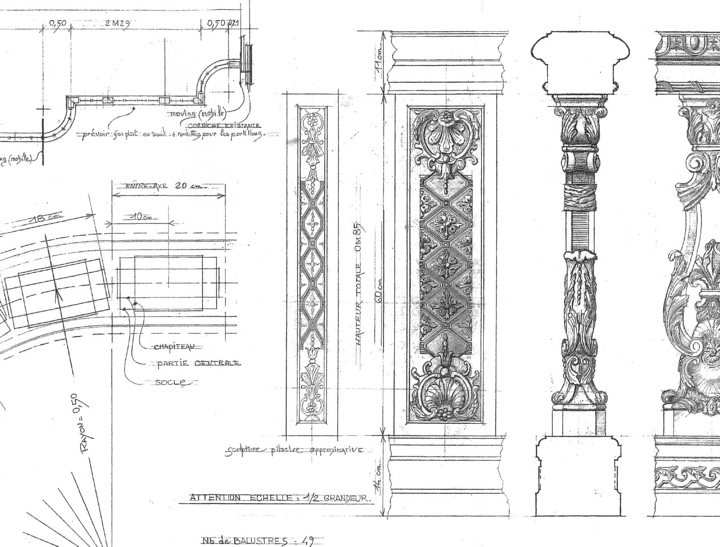
Marie Antoinette, detailed bedroom plan. Click to see fullsize image.
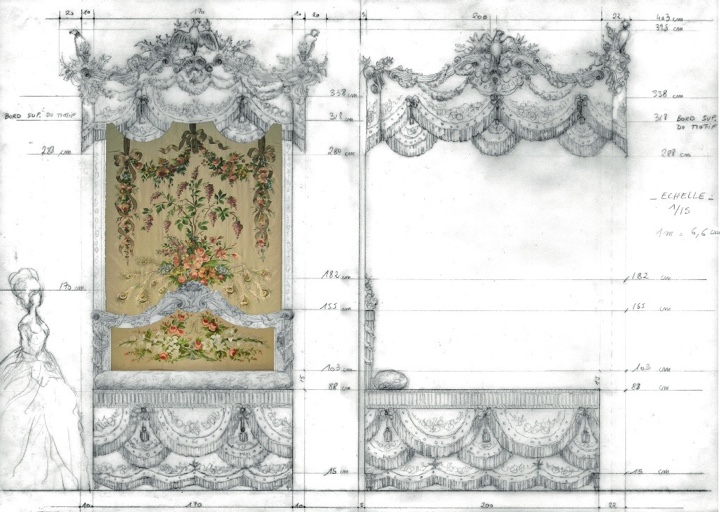
Marie Antoinette, detailed bedroom drawing.
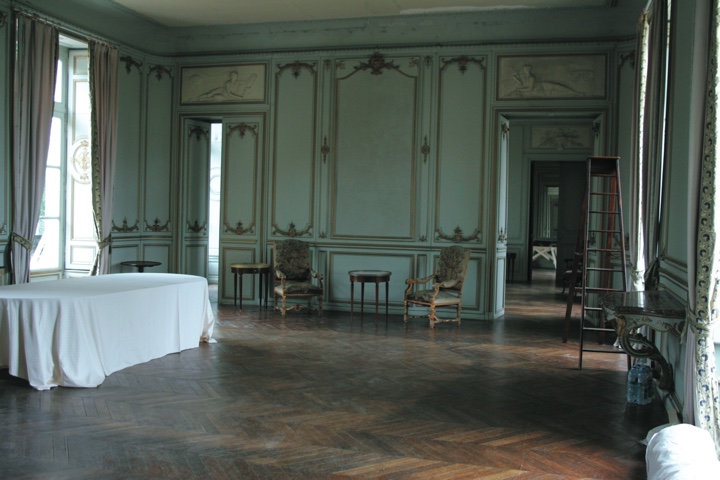
Marie Antoinette, bedroom location before decoration.
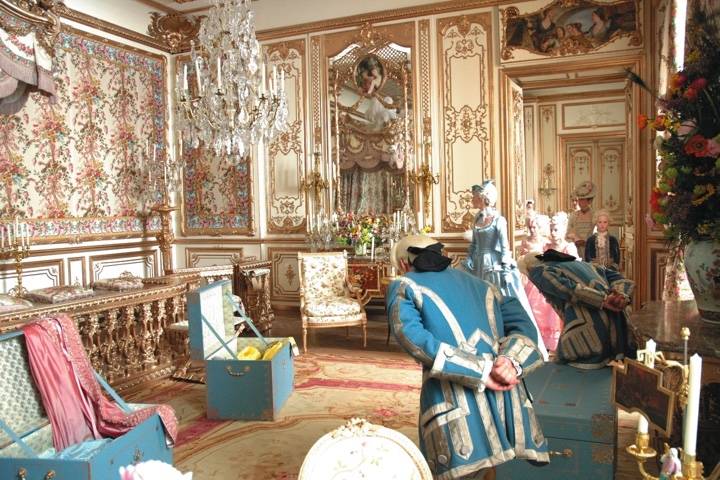
Marie Antoinette, bedroom location after decoration.

Marie Antoinette, final stills.
Kirill: I was just recently watching “Marie Antoinette” again, and it is so unbelievably rich in color, texture and incredibly lush set decorations. How did it go on your side?
Anne: It’s one of my best memories. It was such a nice and warm vibe working with Sofia Coppola. I did a lot of research, and had a real thrill doing all the construction. It was such a pleasure to go into the smallest details reproducing Versailles, to see how it was done – a really good way of learning history, better than at school. It was fantastic to go to Versailles, to meet the people who maintain the gardens and to talk with historians. I met this completely mad woman who is collecting everything about Marie Antoinette, and it was really incredible to see some of the pieces. It’s a really interesting part of our job to do the research, to put yourself in a different period.
We also spent a lot of time on small details. For example, we made extensive camera tests to find the right color of the gold. We didn’t want it to be too pink or too green, and you might not have noticed it, but it does not feel cold. We looked very carefully at colors and fabrics, and how they reproduced on the screen.
Kirill: This brings me to your latest movie, “Midnight In Paris”. It also has a very stylish look from the very first opening sequence. As the production designer of this movie, what was the initial exploration stage between you, the cinematographer and the director?
Anne: Woody Allen movies are different. The very first thing they told me during the interview – no construction, as Woody does not spend more the 10 million dollars per movie. With such a small budget for art department it was a challenge to do this movie in France. As soon as casting was over and I started working on it, I spent a lot of time researching the period. It was about two months before the shooting started, watching films, reading books and other materials.
I had very little discussion with Woody Allen. I saw him for an hour in New York, and about half an hour in Cannes after I’ve already looked at different locations that I could transform and adjust for the different periods of the movie. The contemporary period was the simplest, even when we tried to achieve a certain look with the cinematographer Darius Khondji. When I first met Darius, I gave him all my research to get on the same level. We worked closely, particularly on the colors and light of the period – brown, maroon and beige – and brighter colors for contemporary, to give a sense of passing from one period to another. And we had these great conversations about colors that I wanted to use, and how it fit into the look that he was targetting. We also talked a lot about the lighting and the practicals that we equiped in a certain way to affect the mood. I had another DoP (director of photography) calling me and asking how we managed to achieve this unity of lighting – and it’s because we worked together from the beginning on colors, texture of the shade, vibration of the bulbs and dim of the lights.
We had a task to find a modern location which we could use for 1920s within the budget restrictions, to find a solution that makes the viewer believe that it is a location from that period. “Moulin Rouge” was a particular challenge for me, my art director and my construction manager. The original building from the beginning of 20th century does not exist anymore, and there are very few concert halls or theaters that could be used to reproduce the original structure. We found one concert hall that hosts rock concerts, with a balcony running around it, and I took Darius there to show him the space that I will transform with false wooden floor, built ballustrades, drapes and period lights. I chose this place and studied a few visual elements that would attract the audience’s eye – light bulbs, peelers, table, railings – particular pieces that I found in the period references from my initial research. We managed to achieve the look we wanted with the mood and lighting by Darius, and if you look at the references, it’s the same feel.
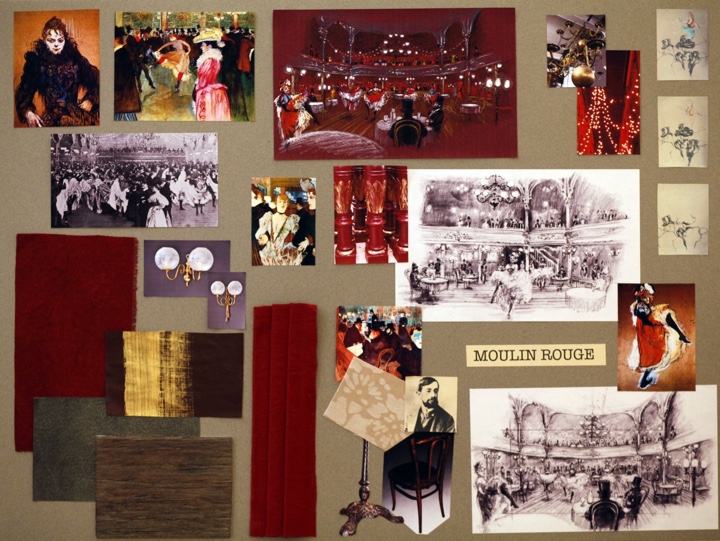
Mood board for the “Moulin Rouge” set by Anne Seibel.
When I went there with Woody, it was completely empty, and I thought that if he doesn’t like it, we don’t know what we’re going to do, because we only had one place. We used drawings and mood boards, and I sold the idea of shooting at that place, and everyone was waiting as Woody and I were standing alone in the middle of it, and he said “that could work”. Everyone was relieved, and that’s where we did it, a combination of finding little tricks and keeping within the budget.
Kirill: You mentioned that you wanted a distinct look for each period, but the first transition was almost unnoticeable. Owen Wilson gets into the car, goes into the nightclub, and it took me some time to realize what is happening. Was that intentional as you slowly introduced different costumes, lighting and colors?
Anne: As the car goes up the road, we started removing modern items, as the car itself, and the people and their costumes are telling that it’s different. It’s not telling it straight away as it can be people going to a dressing party, but as they’re stepping outside, they come into a place which has the real look of 1920s, the costumes, the furniture, the mood, and that slow transition was intentional to make people realize what is going on. We want to make a bit of mystery surrounding the midnight, and I like the way we did it.
Kirill: How much time overall did you spend on the movie?
Anne: The filming was seven weeks, the official preparation was also seven weeks, and I personally researched for two months before that. We shot it during the summer, as Woody calls them “Woody Allen summer projects”.
Kirill: What happened during the preparation?
Anne: When Woody came five weeks before the shooting began, I had visuals and mood boards to illustrate my vision. Most of the time it worked, and we only spent a lot of time on the Pigalle set. Woody wanted to go to that district which is very modern with a lot of neon lights, traffic and sex shops. We looked around a lot of little streets, and we ended up in Pigalle narrowing the space. If you go out of the frame, it’s all modern, but within the frame it was our magic – change the facade, change the lighting, change the coffee shop furniture, the posters, the cars in front – just the magic of dressing.

A sketch of a 1920’s restaurant exterior.
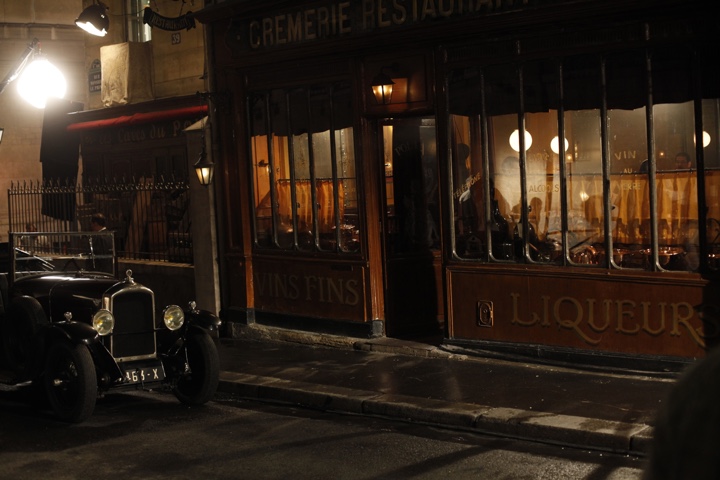
The decorated exterior of “Polidor” restaurant by Anne Seibel.
There was also a place that I found, and I really liked it, and it was completely unusual and not even part of the script. Some of the Zelda Fitzgerald’s cocktail parties were supposed to be in an apartment, and this place I found was a museum for fair pieces, with old merry-go-rounds and game machines, was so incredible, with such a strange dark ambience, that I had to take Woody there. When Woody went there, he was like a child and he changed the script to have the party inside this place. It was the look of the place that made him change the location.
Kirill: Did you spend a lot of time decorating the hotel room where Owen Wilson and Rachel McAdams stay in the modern period?
Anne: We shot it on location in “Bristol” hotel. We changed things according to the script – the lights, the curtains – just dressing it with props and flowers. We didn’t do anything major, but there are always some adjustments to do, especially with lighting because it’s very complicated to film in a small area. We did a lot of research on different hotels, and this was our favorite.
Kirill: Did you enjoy working within the tight limitations of the budget?
Anne: It’s a challenge, but at the same time the budget is never enough, even on big movies. You just never have enough money. I enjoyed this challenge, and I liked that the producer Raphaël Benoliel brought this movie here [Paris], and he made us feel as one big family on the set. It was a pleasure working with everybody, communicating, working for Woody Allen, making his movie the best we could.
Kirill: Do you have a favorite scene?
Anne: I really enjoyed “Moulin Rouge”, mostly because of the set, and all the scenes with Gertrude Stein [Kathy Bates]. I also liked the surrealistic wedding at the taxidermist “Deyrolle”, where we created special lamps with feathers, working around the wild animals. We managed to create a different look for different scenes, instead of going for a traditional look of apartments or restaurants, and I’m very pleased with this movie.

Mood board for the Gertrude Stein set by Anne Seibel.
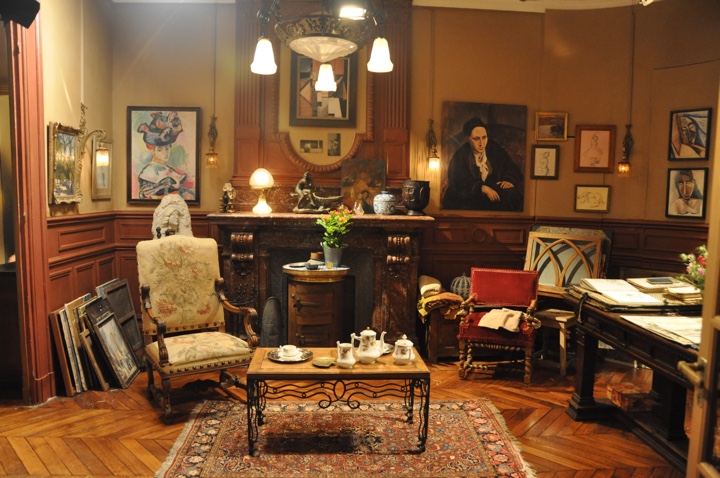
Final decorated set for Gertrude Stein location by Anne Seibel.
Kirill: You worked on different types of productions, periods and looks. Do you have a favorite one?
Anne: Contemporary movies set in usual locations interest me less. Woody’s next movie, “Nero Fiddled” is set in Rome, and although it’s a contemporary movie, I tried to find unusual locations to serve the script, giving various different look at the same time. I’d love to be able to work on a fantasy movie, where you can completely let go of your imagination and go crazy, like on Tim Burton productions.
Kirill: Can you recommend a few of your favorite productions?
Anne: It is hard to choose a few. “Midnight In Paris”, of course, is my first recommendation. The film I will watch again and again with a true pleasure. “E.T.: The Extra-Terrestrial”. I am a fan of Tim Burton and Terry Gillian. Recently I enjoy very much the Polanski film “The Ghost writer” and I liked “Avatar”, for the look of it, and because I’m a great fan of Rick Carter. I really loved what he has created in the Avatar world.
Kirill: Do you start analyzing the production aspect of movies when you go to the cinema?
Anne: Sometimes. I look at it, because it’s my job, and I like movies in general. When I saw “Midnight in Paris” for the first time in Cannes, I was drawn into it even though I worked on it. Woody did a really beautiful film with what we created for him. When you work on a movie, you don’t realize what will happen and what the director is going to do with it. It was very clever in the way he put things together, and I was totally drawn into it and I believed in it myself, even knowing how we set up the scenes.
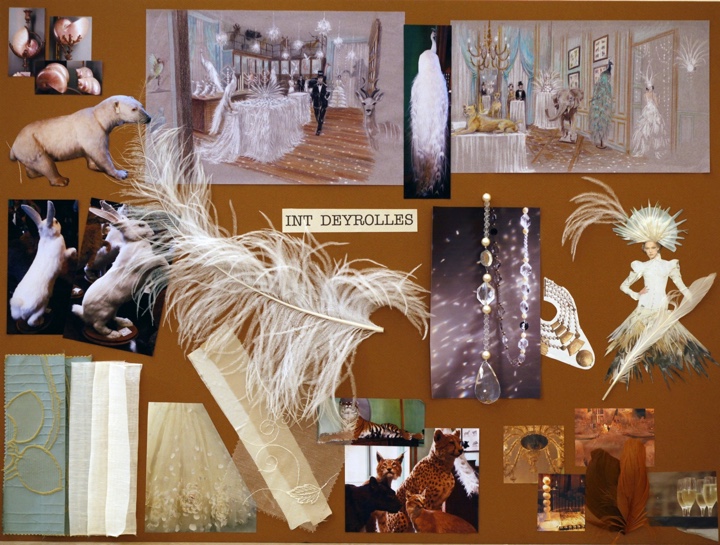
Mood board for the “Deyrolles” surrealistic wedding by Anne Seibel.
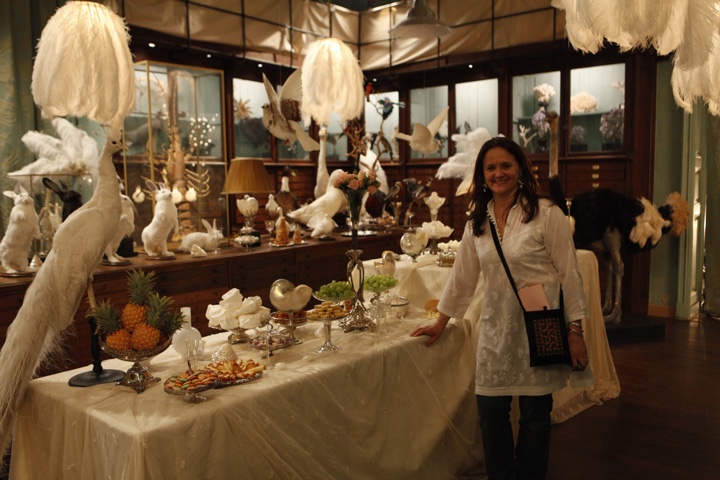
Anne Seibel on the constructed set of “Deyrolles”.
And here I’d like to thank Anne Seibel for the interview and the supporting materials, and Rebecca Fayyad of Sheldon Prosnit Agency for putting me in touch with Anne.
In this interview the cinematographer Jonathan Freeman ASC talks about what drew him into the craft, the slow transition from film to digital and the art of lighting. In between he walks me through the creative process behind his recent movie “The Edge Of Love“, from choosing the locations and defining the visual language, to capturing low-light scenes, post-production color matching and integrating visual effects.
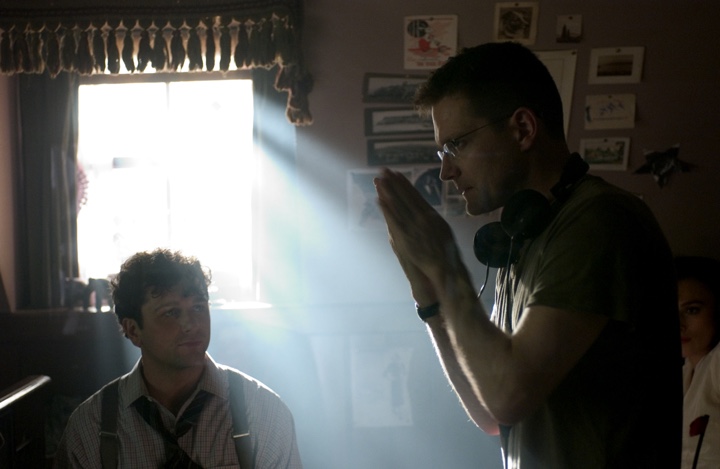
Jonathan Freeman on the set of “The Edge Of Love” with Matthew Rhys and Keira Knightley.
Kirill: Tell us about your background and why you decided to pursue a career in cinematography.
Jonathan: I was born in Canada. After studying in Concordia University in Montreal I began my career doing low-budget Quebecois dramas, even though I spoke very little French at the time. Then I moved to larger projects as I built my reputation, eventually leading to larger American projects. Around twelve years ago I moved to New York as I was receiving more offers from American productions. For the most part I shoot drama, whether it’s for features or for television, and also some commercial work.
Kirill: Were you always interested in making movies?
Jonathan: Going back many years, I was always drawn to movies. It was the first “Star Wars” film that pulled me in as a kid and, like a lot of people in my generation I was blown away by the spectacular special effects. The opening sequence, with the ship flying overhead, felt so real; and then the camera tilting down to show a planet that looked very much like Earth – as a ten-year old I wondered “how did they shoot that?”
As much as I was captured by the story, I was even more intrigued by the magic that was in front of me and I wanted to understand how that magic was created. And from that simple process of being inspired I went to see the movie again and again and then again. My mother was a painter and she taught me a lot about light and color, and my analysis on why it seemed so real was the magical element in how the camera was used to photograph the models. In addition, the way the models were lit seemed to be very realistic comparing to the space photographs of the period.
Throughout high school I was interested in great directors and cinematographers. Bertolucci and Storaro were particularly influential. My generation was fortunate enough to be at the advent of VHS home movies available for rent – as an essential tool to study movies at home. Sometimes when I was overwhelmed by certain movies during the first viewing I would go back and watch the specific sequences to see if I could figure out how they achieved their beautiful work.
Kirill: You mentioned the word “magic” when you described your first impression with “Star Wars”. Were you disappointed as you started dissecting the actual techniques, unravelling the illusion and masterful deceit?
Jonathan: It was actually the opposite. I marveled that someone was able to create this illusion. I particularly was impressed with the work of the team led by John Dykstra ASC who supervised the special photographic effects on the original movie. It was good to see that there was this group of people who were able to achieve this, and it was inspirational in a way that I wanted to do what they were doing.
Kirill: Looking back at those years in high school where you would rent these precious VHS tapes and rewind the specific sequences to study and analyze them, how would you compare it to the abundant access to an ever-expanding selection of high quality digital media in the present day? Does that affect the genesis of the next generation of cinematographers and movie creators on one hand, and the movie fans on the other?
Jonathan: I think more access means more information, and it’s always a selective choice. If I was born ten or fifteen years earlier, I would have been more restricted because the only way I could have reviewed movies back then was with 16mm prints or repertoire cinemas. Overanalyzing things doesn’t necessarily help either, but the ability to have access is a good thing.
There’s a bigger question when it comes to the current and the next generations, certainly for cinematographers, as the digital medium overtakes film. It’s much like the way the digital still camera has lost the magic of still photography. First of all people don’t even look through a view finder anymore, and even if they do look at the camera monitor, they’re already half-editing the shot before the moment it could be created. There is a great deal one can learn from trial and error. When you look at the work Robert Frank did with a still camera on the subway, he would often have it on the shoulder strap not even looking through the view finder, taking a shot of what he thought was interesting. He was able to capture these images confidently because he imagined what his camera was seeing without looking through it. That requires a lot of trial and error. He may not have known for certain whether he got an interesting image. Only later when he would look at the negatives and proof did he discover what would become very iconic images.
I think that kind of magic is being eliminated. The experience of not knowing for certain whether you have captured the moment is surely different from shooting in a digital production – there’s a bit of a loss in that respect. Does it mean that the work of the next generation is not going to be as good, or even better? I don’t know. There might be a gain in other areas. But I certainly love film.
Kirill: Is it a loss in the sense that instead of relying on your artistic instincts you’re guided by the immediacy of the visual feedback, not only for you, but for the rest of the production crew on the set?
Jonathan: I have to admit to sounding a bit like a dinosaur. There’s a certain value to understanding the photographic latitude that the film required you to learn. It would involve thinking about the stock, the lenses, the filters, setting the correct exposure value to cover what you’re looking at. The kind of experience that you eventually gain through shooting film is valuable in how you understand and appreciate the technical restrictions of the medium. Of course similar things happen when you shoot video, analyzing the exposure outside the windows and compensating, but for me it comes back to the magic of it.
It’s not something that derails the potential quality of cinematographer’s work, but I do think that emerging cinematographers would benefit from shooting film. Even still film is a good learning tool, as well as shooting in black-and-white. When you shoot in black-and-white, you get a much more appreciative idea of contrast, and the lack of color separation forces the photographer to find ways to create separation.
Kirill: So through restricting yourself to a different physical medium you’re becoming a better artist?
Jonathan: I wouldn’t qualify it as better, but definitely more versatile. I don’t consider myself a very technical cinematographer, and there are a lot of things I wouldn’t be able to tell you about a film camera and certainly about a digital camera and their basic components. I do understand the principles of exposure value, and as a cinematographer it’s critical for you to understand, not just for the immediate moment when you’re recording on film or digital, but for the final projected and broadcast result.
Kirill: What was your choice for “The Edge Of Love”, film or digital?
Jonathan: It was actually a mix. It was probably 40% film and 60% digital Panavision Genesis HD camera. This was by choice and not necessarily aesthetically. I was working with the brilliant director John Maybury, and it was actually our second collaboration in a period of less than a year. We worked together on an HBO series “Rome” which we shot on film, and at one point I was shooting digital stills to give him an idea of what the result might look like. We were talking about monitors which are either too bright or don’t represent what I’m exposing, and I realized that it would be helpful for both of us to see an image that is much closer to the end result. This way I could go even darker in the scene because he was OK going that dark, because he felt more confident that he was seeing an accurate image. Before I would be more conservative regarding exposure, and as a cinematographer you rather expose the negative as close to your intended result. I thought that HD was a good attempt at resolving this.
However, as we were shooting a portion of the film in Wales, it didn’t seem that Genesis was a system comfortable under different weather conditions. Never knowing what you would get in Wales, and for efficiency reasons (not being tethered to HD) I just felt it would be OK to shoot that portion on film. As it was meant to be stylistically separated in anyway, I shot the Wales part in film, a kind of a dreary Tarkovsky landscape – in contrast to a more vibrant night London.
And so we shot our first three weeks on film in Wales and then came back to London and switched over to HD. I think it worked out pretty well.

Left – close up of Sienna Miller – 35mm film. Right – close up of Keira Knightley – HD digital.
Kirill: Are you more limited by the bulkier HD cameras that often run thick tether cables back to the recording booth?
Jonathan: It was back in 2007. The current technology comes with its own version of recordable sources, so that you can record without being tethered to a cable, apart from some recommended dependent systems. Regardless, even on film we’re used to an attached video cable that provides video playback, and at the time it was the choice that we felt to be more efficient. Today, in the same exact scenario, I would probably assume to shoot in one format or the other.
Kirill: Given that your most recent work on the “Boardwalk empire” is on film, do you see yourself continuing this in the next five to ten years?
Jonathan: It’s becoming progressively less of a choice, being driven by production considerations as well. In some cases the production will be willing to consider doing film as long as there’s a financial give back on our end in some way. Shooting straight film is very costly, and the cost of DI [digital intermediate] stage has come down to a point where posting your film in anything other than digital intermediate is not even affordable. Digital has improved rapidly year to year, and it’s possible that in five years a system will come out and it is really superior to film.
When it comes to low light levels it’s hard to argue against HD even with the highest quality film. It’s at least comparable, if not more successful – depending on what you’re talking about. It’s certainly comparable in grain and resolution, and it’s harder to narrow down in regards to color range as different systems respond differently into the low end. But when it comes to highlights, HD is overall universally challenged and film is still superior, but that will change.
I said ten years ago that film will be dead. Maybe not in ten years [laughs], and hopefully there will still be opportunities to shoot it because it’s a beautiful format. But being conscientious of the environment, video is much better for the planet.
Kirill: Transitioning to your role in the overall production process, what does a cinematographer do?
Jonathan: The director usually hires the production designer first, and that was the case on “The Edge of Love”. John has worked with Alan MacDonald for many years; a cinematographer’s dream to work with. Alan worked on principal ideas before I came on board, and after I joined we started adding to and reshaping the script into what John was visualizing. They are both very collaborative, and together we developed various ideas for the scenes, going through the script.
It was over a period of weeks, where we would gather notes and sit down scene by scene, discussing different locations and how we would approach things. John would tell me how he visualized opening the movie, and we’d work together to figure out the shot elements. Alan would have ideas on specific imagery that he researched and found, and we’d apply those to certain scenes.
Kirill: Did you drive to locations across Great Britain, shooting stills and bringing them back to discussions?
Jonathan: Exactly. In some cases we studied generic photographs of locations, and at other times we would discuss very specific angles that one of us thought to be a strong support for the story. Sometimes the locations didn’t look exactly as I wanted them to be, so I photoshopped the pictures to give a stronger impression to John, or I would take his thoughts and apply that look.
Kirill: And the goal was to have a prototype of the intended visual style?
Jonathan: I’ll give you a few examples. Many years ago John had found this beautiful location in Wales, and he wanted to use it for the sequence of Cillian Murphy‘s character at war (that took place in Greece). Even if it doesn’t make logical sense as it doesn’t look like any specific location in Greece, the black slate quarry surrounding the hillside is very dramatic, and after going there, we tried to figure out the sequence. The script as it was originally written was very true to the story, but not very dramatic. Cillian’s character was originally tasked with digging up land mines, but as he was not blown up or exposed to direct violence, we needed to give him a little more heroic angle.
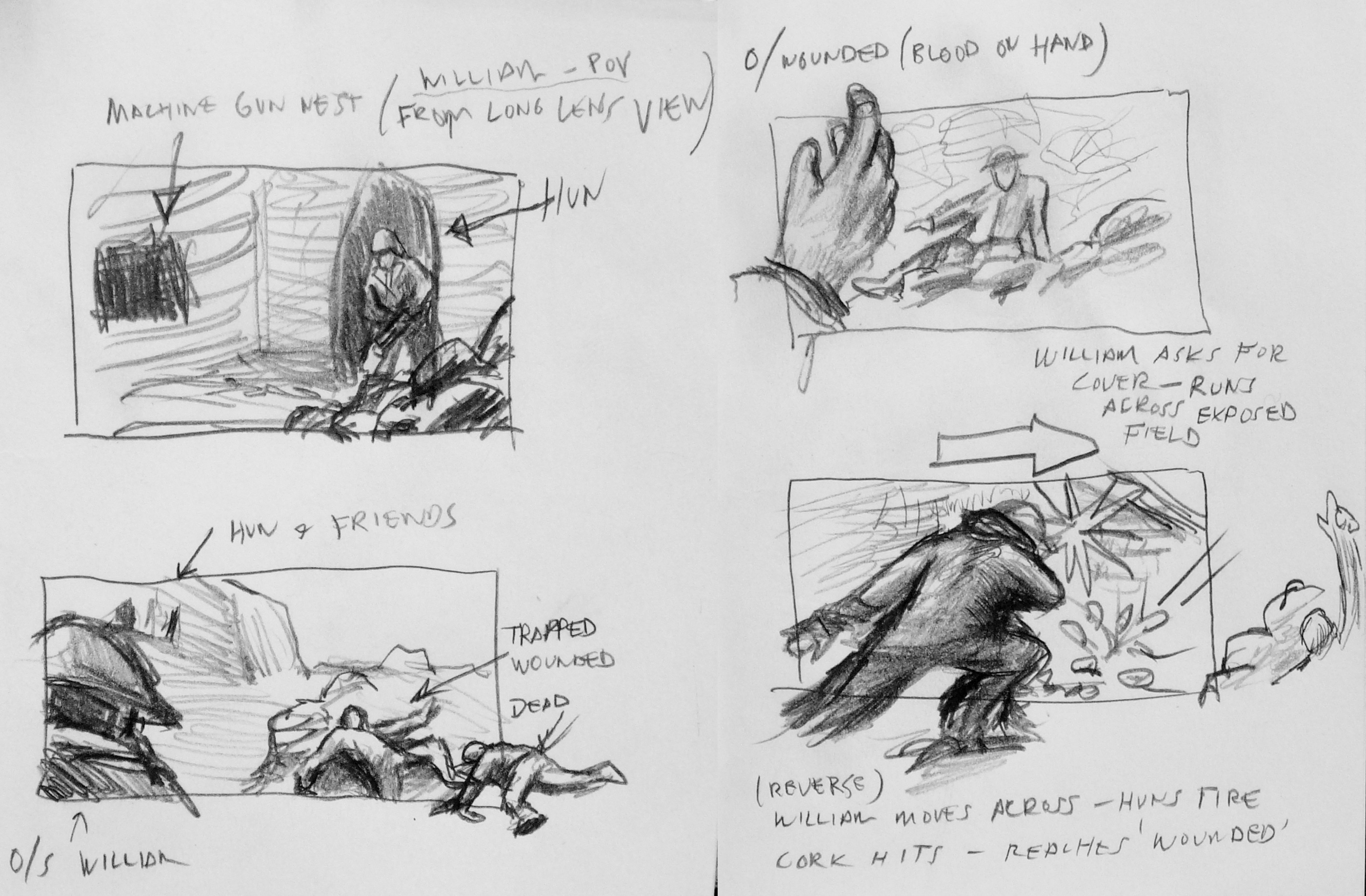
Hand drawn original boards by Jonathan Freeman.
So we had to reconceive the sequence – with very little money – to tell the story not only of his character, but also the potential psychological and traumatic experience at war. In addition to the field surgery scene, we needed another one of battle, and we only had seven hours to shoot it. It was done in a way that was as simplistic as we could do it, with great help from the brilliant “Double Negative“; the digital effects company behind “Children Of Men” among countless other projects. They delivered some of the missing elements in the scenes that we pre-planned and shot.
This specific sequence begins with Keira Knightley‘s character writing a letter, and then, when she hears a plane, we cut to the plane above and transition to the battle scene. Originally I suggested that the plane is going away and we tilt down with its movement, but in the end we flipped it to an advancing plane and tilting from there, as the visual effects company thought it would be easier for them to do. And all the elements including the CGI planes were cut together to create a sequence which I boarded as a reference, and in the end it came pretty close to what we’ve planned.

Another concept of a sequence was with Cillian and Keira huddled together outside the bombed night club, just before he was shipped to war. Alan had this image of a firefighter during the blitz, as a silhouette hosing down the fire.
Kirill: This was a nice transition from a glamorous dance hall interior to the grim reality of a wartime London.
Jonathan: This was John creating an experience of the time, where you live on the edge, risking your life on the daily basis – and a lot of characters are right on that edge. You risk a lot, but you feel that you live the best that you can under the circumstances.

And the sequence that we could afford, without a big spectacular CGI fire scene, was based on this photograph. We looked around London to find a place where we could recreate this practically, without it becoming a huge thing. I don’t remember the exact location, but it was close to the theater district, sort of a narrow alleyway, where we were able to frame their silhouettes against what ended up being a cluster of lights on a tower, with a lot of smoke and some guys hosing a building offscreen. This is sort of a typical illusion that ends up feeling more expressionistic – which is what we wanted to achieve in much of the London portion.
A lot of John’s movies and approaches are expressionistic and suggestive. That image didn’t have real fire, but you know it’s fire because of the color and the logic behind it. You never see the collapse of the interior of the night club, but you get a sense of it when the chandelier is down and everything goes black, and it’s just search lights panning over the victims while our heroes escape. And this is John’s visual way of interpreting simply something more spectacular, in a somehow more gratifying way.
Kirill: You talked about your collaboration with “Double Negative”. How does it work during the post-production as their digital output is merged back to the live action sequences?
Jonathan: The color correction was done at Framestore. Brian Krijgsman is a true artist, and he was very integral in delivering another layer of the look through his expertise and patience. He would show us things that he could do with the system, and it’s unfortunate they’re no longer doing DI [digital intermediate], as their system was the best DI experience I’ve ever had.
Digital intermediate is essentially color grading or color timing which happens at the final stages before you do the film print. It used to be done chemically, but now it’s a much simpler process. You also have other things which you couldn’t do in standard film timing, like power windows where you can darken or lighten part of the frame, more versatile range of color and exposure adjustment.
Kirill: Did you participate in the post-production stage?
Jonathan: The visual effects company was certainly involved during the integration of their sequences. But overall it was again myself, John [Maybury, director] and Alan [MacDonald, production designer]. Although it doesn’t always happen, I wanted Alan to be there as well. It was important for me to see him getting value on the images that we collaborated on. If he felt that the initial exposure missed out on a certain set detail, I’d be very happy with him going in, taking that detail and bringing up the exposure. John also was able to highlight other aspects of the frame whether it was costume or an actor’s face.
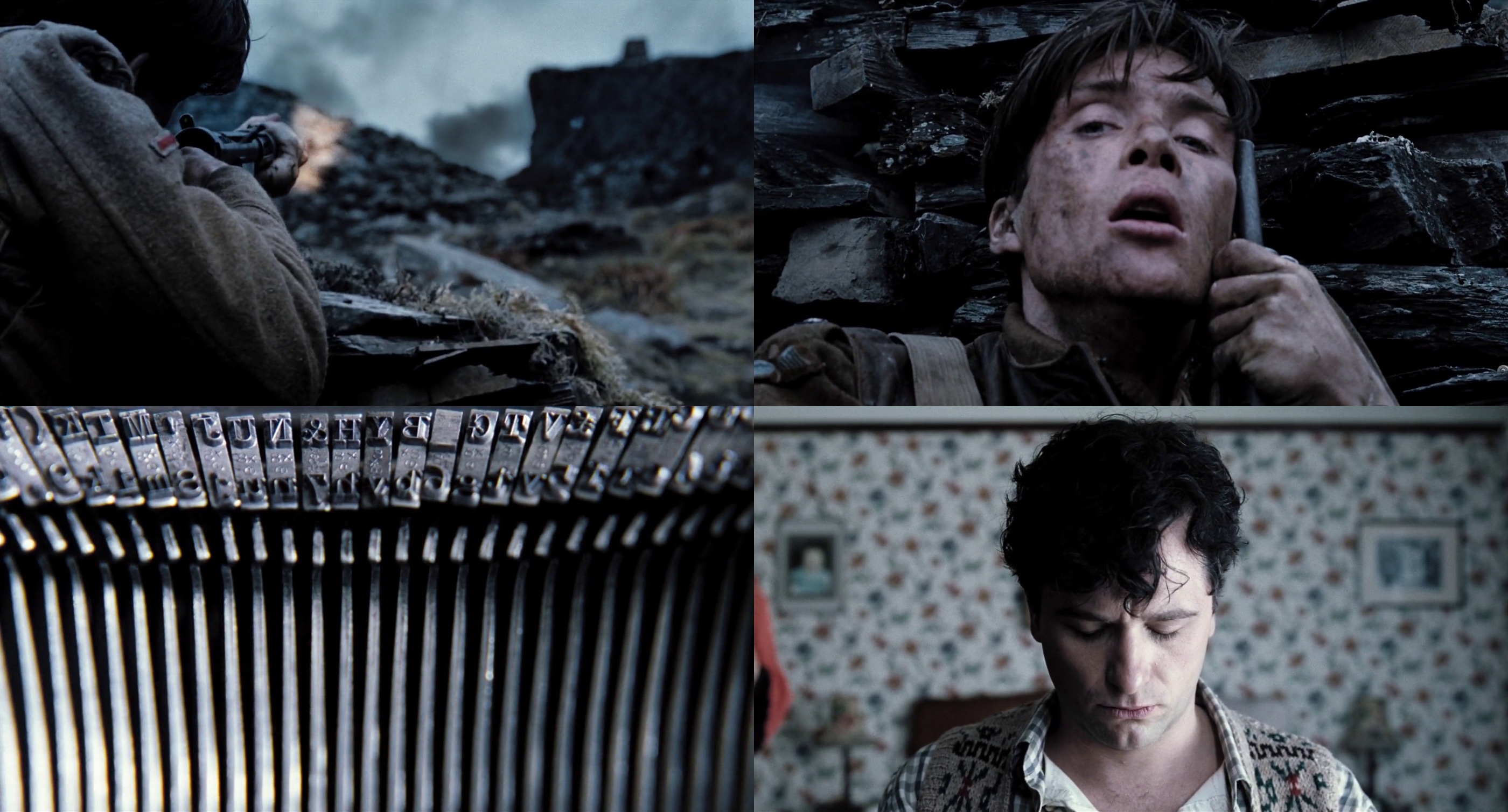
The staccato of bullets morphs into the staccato of typewriter, aiding the visual transition from war back to peace.
Kirill: How much time did you spend during the post-production phase?
Jonathan: Once the shooting was complete, the editing took a few weeks. It was fairly quick edit, and we did the color timing within six-eight weeks or so, and we spent two weeks at Framestore which has been an excellent experience for us.
Kirill: What was the daily routine of looking at the output of that specific day?
Jonathan: We did what most people do – watch DVD dailies. It was a standard analysis, and it was more critical in Wales as we were shooting film. It became less critical when you’re shooting HD as the dailies that you get are essentially the same as you see on the set – which was another advantage of HD, as you’re able to see the immediate output collectively.
Kirill: The London scenes were done in very low light, immersing the viewer in the environment that required the citizens to close all the windows and use as little light as possible. Was it more challenging to shoot London scenes from the lighting perspective?
Jonathan: In some ways that was my biggest challenge. I remember John joking about how was I going to figure this out. Technically speaking, we took some liberties in terms of what we got away with, but basically the exteriors of London at that time were pitch black during the night because of the mandatory blackout during the blitz. At night you can’t use any artificial light as your source. It’s essentially what they classically describe as moon light, and I personally loathe this idea. Moon light tends to look very artifical on film when it’s recreated, and you can’t shoot in the real moon light. There’s very few examples in cinema which I’d describe as great moon light.
There’s a choice, and I felt that a more subtle ambient sky light in a cloudy overnight cast – as opposed to a harder single-source direct moon light – will cause your eyes to eventually adjust and see something. And on top of that we’d have the search lights illuminating the clouds, so theoretically between that ambience and the natural ambience of the moon light filtered through the clouds you’d have your light source.
We could justify the artificial tungsten lights for the interior scenes, and the blocked windows provided a nice contrast between warmer interior and cooler exterior as the light did not enter from the outside. I had my biggest challenge in the scenes which were not supposed to have any light sources at all.
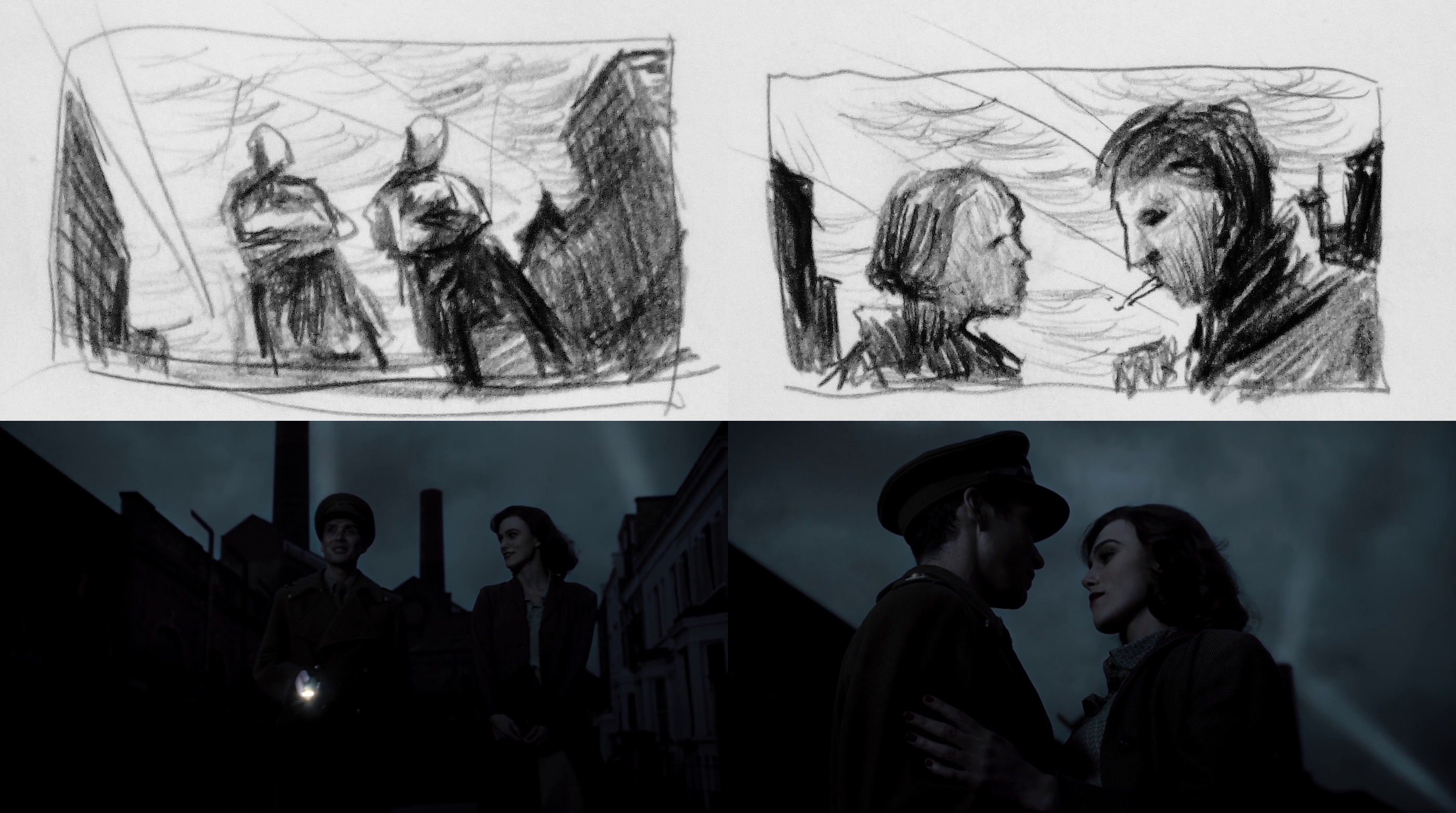
Top row – hand drawn original boards by Jonathan Freeman, bottom row – final stills.
The sequence where Cillian is walking Keira home, and there’s a street in Chelsea with this beautiful factory, and we asked ourselves how do we show the scale of the street without it looking false. You can get a big light way down the street, and that becomes your moonlight – but I felt that it was very artificial. And the alternative that I came up with was no less artifical, but more aesthetically interesting. We shot the sequence in one shot at magic hour, with the intention to take most of the street and the figures, bringing the exposure down so they’re almost silhouette walking against the sky that we eventually replaced with visual effects.
Part of the framing was to keep the characters silhouetted against the sky, because otherwise they would be buried against the dark architecture.
Kirill: And there you lowered the camera to show more sky and less cityscape
Jonathan: Exactly. This would silhouette them more distinctly, and would provide the opportunity to show the search lights that happened at London at the time. I drew some boards for this, and did some photoshop explorations.
Kirill: There were two shots, one at the bar, and another where Cillian and Keira were making love for the first time, and it appeared that you shot them through some kind of a glass structure that resulted in a series of complex overlapping reflections. Can you share your secret?

Jonathan: That’s the pure genius of John Maybury. We shattered a large mirror and selected a portion of the mirror break that seems to be the most photographically interesting, with fragments large enough so you can capture almost the full image.
There are two things that happen. Since the fragments are not flush to each other, they capture slightly different degrees of angles of the same image. We’ve asked the actors to start pretending to make love, and as that’s happening we shot them in profile through the mirror and panned while using a series of zooms to give the camera some movement. Then we created a dissolve effect which we did through a series of shots. Because of this, we had this magical moment in two or three shots, as they separate from kissing, there’s a silhouette that happens where their faces seem to merge together to become one. John knew we would get something interesting but this was one of those magical moments you can’t plan for. It was very lucky actually.
Kirill: Would you describe this as going with the flow, as it’s hard to plan for?
Jonathan: You can plan for it but it’s, again, the magical element. We did a lot of very precise planning, but things like that are organic and it’s fantastic when it does happen. You know you’re going to get something interesting, and John knew confidently that he’ll get something that he could use. Following his lead I knew that as well; but we didn’t know what we would get in moment. On camera it works photographically in a way which is very abstract and beautiful.
John is a brilliant artist and a great person to work for and work with. He inspires you in a lot of ways, and encourages you to contribute, which is the best collaboration you could possibly ask for.
Kirill: There were a couple of scenes with very strongly defined pyramid of light penetrating the windows. Was it your intent to have this in scenes where Cillian’s character is not present, highlighting the more feisty side of the other three characters?
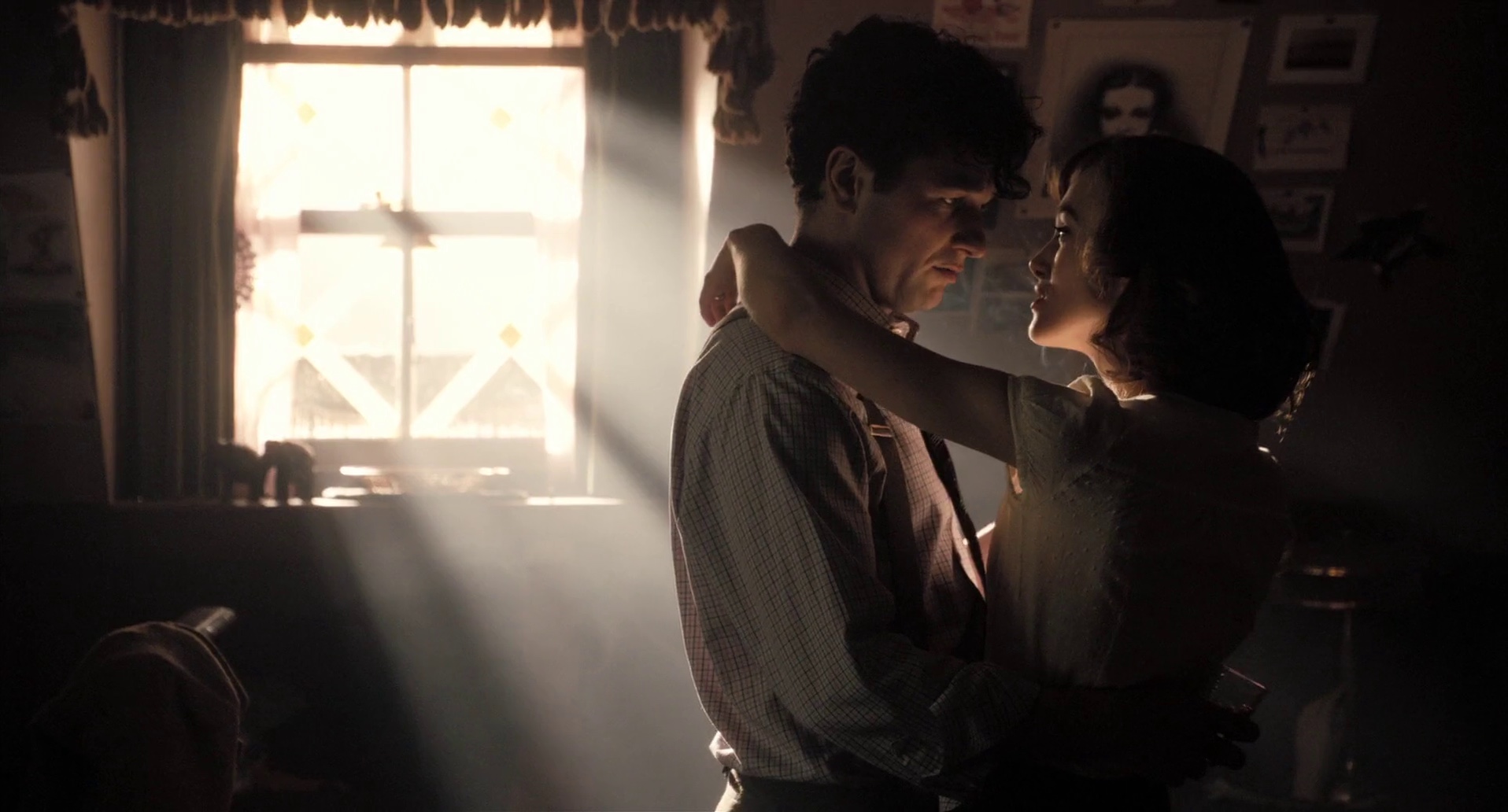
Jonathan: I like the analogy of pyramid of light. We definitely wanted to frame Cillian out of the shot, but I’m not sure if this type of light was the right call. You certainly don’t get a lot of sunlight in London, but that scene needed a contrast to highlight the potential jealousy from both Cillian and Sienna [Miller]. We needed something less gloomy to elevate an image of Dylan Thomas played by Matthew Rhys, as he and Keira are sort of enveloped by the light, digging the knife even further into Cillian’s character.
Kirill: As it wasn’t direct sunlight, how did you achieve these visuals?
Jonathan: It was a very simple standard technique used by a lot of cinematographers. We used a 10K tungsten Fresnel light which can be used for sunlight effects, placed outside the set. I wanted this shaft of light to be even narrower, but we didn’t have enough space in the studio. So I bounced the light into a mirror, and then it would be directed into the window. Since the reflection of the light has to travel twice the distance to the window, it effectively moved the light further back from the window. Otherwise if you put the light too close to the set, its quality becomes too wide and unnatural. The placement itself and the backlit quality makes it more impressionistic, but still has a natural quality to it.
Kirill: You said in the very beginning that you were immediately drawn to analyzing and understanding lighting as an integral part of the cinematographer’s craft.
Jonathan: I can’t imagine being a cinematographer not constantly thinking about the light. Obviously the composition and framing are incredibly important too, not only to be aware of, but to be an active participant as well. But to be fair there are a lot of directors that know where exactly they want the camera to be. Some others may not have an idea where they want the camera, preferring to work with the actors. When that happens occasionally, I then try to find different alternatives to cover the scene – so it can spark a discussion. But most of the time it’s somewhere in the middle as a collaborative process, building together a shot design based on the director’s ideas and my suggestions. And even if there are few directors that have specific ideas for the look of some scenes, the cinematographer’s principle essence is the light, or lack thereof. It begins and ends with light for me.

Capturing the magic hour. Top left – test mockup during construction (waistcoat and gun added in Photoshop). Top right – shot from the set, capturing the scale of the house against a fragile character. Bottom row – final stills.
Kirill: You mentioned that digital cameras are not good at capturing highlights or a wide contrast range. Does this contribute to some cinematographers’ opposition to this technology?
Jonathan: I think it would be wrong to say that we’re opposed to it. Five years ago there were a lot of cinematographers swore that film was it. The technology is still not there yet. It still needs to be further developed, it needs to surpass film in terms of full dynamic range and capacity, and once it does that, I think that everyone will understand that a new medium has effectively replaced the old one. But a lot of us are not comfortable with the idea that if a technology gets locked in too soon to be acceptable, then we’ve lost something. If a technology gets to replace another technology, it has to be because it’s better in all respects.
Kirill: That is not necessarily what happened when the music recording industry has transitioned from vinyl to CD. Even though the hardcore audiophiles still swear by the dynamic range and warmth of sound captured by vinyl, the general public does not seem to care as much.
Jonathan: That would be true for cinematography and photography in general. I think there’s another stage where in twenty years digital will be so far advanced in terms of dynamic range capturing that we’ll be requested to make it worse, if you will. There will be functions like today’s hipster apps that will give you a look of the specific film stock that we’re shooting with now, like Kodak 35mm 5219.
Kirill: And even now the visual effects artists are required to recreate the physical imperfections such as lens distortion or film grain, as their output is integrated into the live action.
Jonathan: Going back to magic, the first thing about visual effects is that they have to appear real. There are certain ways in which you can aid that, and taking away the perfection of a computer generated image is one of them. You can do this through lens distortion, light flaring, and film grain – which is still hard to simulate. I’m sure that somebody will come up with a program that will be able to satisfactorily simulate grain of different film stock.
The only way it’s going to happen is if dinosaurs like me, and more influential dinosaurs will keep saying that what we have now is not good enough. If we all say that it’s OK, there’s no reason for the companies that develop these technologies to move forward and to advance and improve their products. So the motivation must come from us to keep their feet to the fire and make sure that this transition into the new medium is done in a way that succesfully surpasses film.
It’s unlikely that twenty or thirty years from now we will look back at the films we shot and people would say “wow, that looks terrible, how would you even think that looked great”? It’s much like the black-and-white films that have their own essence and their own beauty that represent a certain time period of cinematic history. And the new technology that replaces film can have its own marker, but it needs to be at a place where we’re not struggling to achieve things that we can already do on film.

I’d like to thank Jonathan Freeman for kindly agreeing to this interview, and I hope you enjoyed it as much as I did. Special thanks to Kimberly Weston at ASC and Andrew Stadler for their help.
![]()
![]()
![]()
![]()
![]()